Does health care and whitening also cure all diseases? Vitamin c means: refuse to kill.
Vitamin C is an essential nutrient for us to keep healthy. From the needs of the body to whitening health care, the function of vitamin C has also been spread more and more "powerful". Because of its antioxidant effect, vitamin C is highly expected in whitening. In daily life, we often think that oral ulcers and gingival bleeding are caused by lack of vitamin C; Even the barbs on the hands are related to vitamin C deficiency. Is this really the case?
Oral ulcers and bleeding gums are caused by lack of vitamin C; If you love long barbs on your hands, you should eat more vitamin C… … Do you often hear such advice in your life? Many people regard vitamin C as a panacea for all diseases. Is vitamin C really so "divine"? Some people even think that even if you can’t cure the disease, it’s always harmless to supplement a little more vitamin C. Is this really the case?
Myth 1: Eating a lot of vitamin C can turn white.
Everyone has a love of beauty. As the saying goes, one white covers a hundred ugliness. No, because vitamin C has antioxidant effect, many beauty lovers regard it as a good whitening product and take it in large quantities. Some people think it has whitening effect, while others say it has little effect. What is the truth?
In this regard, Li Heng, director of the Dermatology Department of Hubei Provincial Hospital of Traditional Chinese Medicine, said in an interview with the Science and Technology Daily reporter that vitamin C, also known as ascorbic acid, has the nature of acid and strong reducibility, and is an antioxidant. As we know, the root of skin blackening is melanosis, and melanin is secreted by dopa. When dopa secretes melanin, dopa must be converted into baquinone, and the role of vitamin C can reduce baquinone into dopa and prevent the generation of melanin. According to this mechanism, vitamin C has whitening effect. In addition, because vitamin C has antioxidant effect, it can promote the formation of collagen, rejuvenate the skin, thus delaying the aging of the skin and indirectly whitening the skin.
"But it doesn’t mean that the more you eat, the better. It has dosage requirements. If you take a large amount of vitamin C for a long time, it will hurt your body, because vitamin C is acidic, making the urine acidic, and it is easy to form urinary calcium oxalate stones and kidney calculi in the body. " Li Heng stressed that at the same time, high-dose vitamin C can resist the anticoagulant effect of heparin and dicoumarin, leading to thrombosis, which makes patients with cardiovascular and cerebrovascular diseases more prone to cerebral infarction (stroke); Vitamin C and food containing vitamin B12 can be ingested at the same time, which can destroy a considerable amount of vitamin B12, and after a large amount of vitamin B12 is destroyed, people are prone to anemia.
Ruan Guangfeng, director of the Science and Technology Department of the Food and Nutrition Information Exchange Center, said that some people say that vitamin C has good antioxidant activity and can inhibit tyrosine from being activated, so that tyrosine will not become melanin and can play a whitening role. There is some truth in this statement, but there is actually no particularly sufficient evidence.
"However, vitamin C is the synthetic raw material of collagen that makes up the skin, which is good for the skin. Therefore, it can be considered that vitamin C supplementation may be beneficial to the skin, but the whitening effect may not be as effective as expected. " Yan Guangfeng said.
Myth 2: Oral ulcer and gingival bleeding are caused by lack of vitamin C.
In life, gum bleeding is almost encountered by everyone. In the case of fatigue and irregular life, gum bleeding often occurs when brushing your teeth. Some people think that bleeding gums are a sign of a lack of certain vitamins. Is it true or not?
On this issue, a dentist interviewed by a reporter from Science and Technology Daily said that although a long-term serious lack of vitamin C will indeed lead to gingival bleeding and redness (the "scurvy" that sailors suffered from in the past was the reason), unless they don’t eat foods containing vitamin C such as vegetables, fruits and milk for two or three months in a row, except for a few people who are caused by systemic diseases such as blood diseases, most gingival bleeding is the manifestation of gingivitis.
Vitamin C is an acidic organic substance with anti-bleeding effect. When the human body is seriously deficient in it, it will lead to gum bleeding. However, all gingival bleeding cannot be completely attributed to vitamin C deficiency. Modern medicine believes that recurrent oral ulcers are closely related to the immune system at first. Some patients show immune deficiency, while others show autoimmune reaction. Due to various factors, the normal immune system of human body produces immune response to its own tissue antigen, which causes the destruction of tissue and causes the disease. Furthermore, oral ulcer may be related to some diseases or symptoms, such as gastric ulcer and duodenal ulcer caused by digestive system diseases. In addition, anemia, partial eclipse, indigestion, mental stress and high work pressure often cause frequent attacks of oral ulcer.
Misunderstanding 3 lack of vitamin c fingers will grow barbed
In winter, some people are prone to grow barbs on their hands. Many people think that this is because of the lack of vitamin C. Just eat more fruits. Is this really the case?
"Finger barbs have nothing to do with vitamin C deficiency." Li Heng said that the long barbs of fingers are keratinized protrusions around nails, and many people will pull them off by themselves. After pulling them off, there will be keratin defects in some areas, accompanied by pain. The main reason for barbs is that the skin is dry, and the keratin skin will become warped when it is dry. At this time, barbs will be formed; Bad eating habits, malnutrition caused by trace element deficiency, picky eaters or partial eclipse are also easy to form barbs; Tearing is an irregular injury, and the incorrect tearing method will lead to local skin damage, but it is easier to form barbs.
It can be seen from the above that the formation of barbs is not closely related to vitamin C. Li Heng suggested that after the barb appears, it must not be pulled off, and it should be cut off regularly with nail clippers, which can reduce the damage to the skin. At the same time, attention should be paid to applying hand cream to moisturize the skin in time to keep the local skin moist.
Shu Chang, a resident of dermatology department of Peking Union Medical College Hospital, said that finger barbs are usually not related to vitamin deficiency, but are caused by physical friction or excessive hand washing. The finger barb is called perionychial barb, and the perionychial skin where the perionychial barb is located is slightly different from other skin of the hand. This part of the skin lacks hair follicles, dermatoglyphics and sebaceous glands, and is very thin, which often causes various inflammations, chemical stimuli and allergic reactions. The formation of perinail barbs is mainly due to the separation of cuticle because it is too dry. The stratum corneum is the surface layer of thin dead skin and the first barrier of the skin. There is a layer of sebum on the surface of the stratum corneum, which is a natural moisturizing agent, which can reduce the evaporation of water in the stratum corneum, ensure its proper water content, and make the stratum corneum closely adhere to the underlying skin.
The sebum on the skin surface is removed by soap, detergent or physical friction, which will lead to the loss of protection of the stratum corneum and the drying and peeling of the stratum corneum due to excessive evaporation of water. It can be seen that long barbs have nothing to do with vitamin C.
Myth 4: Synthetic vitamin C is not as good as natural vitamin C.
"It’s a three-point poison of medicine" and "synthetic is certainly not as good as natural". People who have bought vitamin C often hear such remarks, so they often spend a lot of money to buy "natural" vitamin C, and manufacturers produce vitamin C products with different flavors and claim that their effects are different. Is there really such a big gap between these products?
Indeed, when you go to the drugstore, you will find that the price of vitamin C ranges from several yuan to hundreds of yuan, and the styles are also varied, including effervescent tablets, chewable tablets and buccal tablets. In this regard, some experts pointed out that the hospital’s two dollars of vitamin C is generally pure vitamin C, which is purely from the perspective of supplementing vitamin C and is a medicine; Most of what pharmacies buy are health care products, which are different from medicines in terms of purification process and added auxiliary materials, which also leads to the price difference. But in the final analysis, under the premise of the same content of vitamin C, there is no difference in efficacy between medicinal vitamin C and health care product vitamin C.
"There is no obvious difference in vitamin C. Fresh fruits and vegetables contain a lot of vitamin C. There is no need to supplement them specially, and they don’t have to eat them every day. Eating too much is not good for the human body." Li Heng said. (Reporter Fu Lili)
China CDC: Compared with antibody detection, nucleic acid detection is more sensitive.
Cctv newsOn May 6th, the joint prevention and control mechanism of the State Council held a press conference on the disease control and prevention work of aiding Hubei.
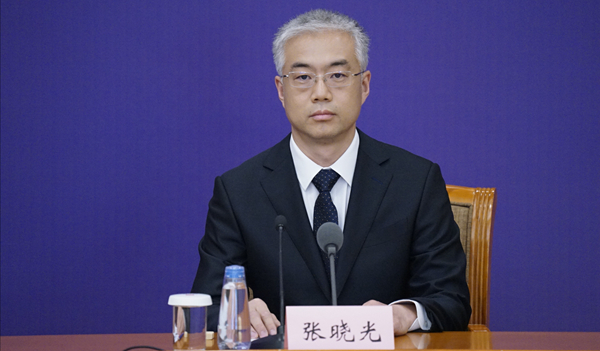
Zhang Xiaoguang, head of the testing team of China CDC in Huanggang, deputy director and researcher of Ceng Yi Institute of Viral Disease Prevention and Control of China CDC, said that after Covid-19 is infected with human body, it will first reproduce in the respiratory system, so it can be judged whether human body is infected with the virus by detecting the viral nucleic acid in sputum and nasopharyngeal swab.
Zhang Xiaoguang pointed out that after a period of infection, usually 7-10 days later, the human body will produce specific antibodies against the virus. IgM antibody appears first, then IgG antibody will appear, so the immunological detection method can detect these specific antibodies and judge whether the human body has been infected with the virus.
Zhang Xiaoguang introduced that the difference between the two is that the positive nucleic acid indicates the existence of viral nucleic acid in the specimen, which means that the infected person may be contagious. IgM antibody positive indicates that the patient is in the early stage of infection, while IgG antibody positive indicates that Covid-19 has been infected, but it is not certain whether it is contagious. For example, recovered people are generally positive for IgG antibody. If the nucleic acid test is negative, the nucleic acid is still negative after 24 hours, which indicates that it is not contagious. Compared with antibody detection, nucleic acid detection is more sensitive, and it is also the "gold standard" for laboratory detection. Of course, both antibody detection and nucleic acid detection have a certain proportion of false positives and false positives, so clinicians should make comprehensive judgments based on clinical symptoms and epidemiological investigation results.
At night, a group drives a new upsurge of urban consumption.
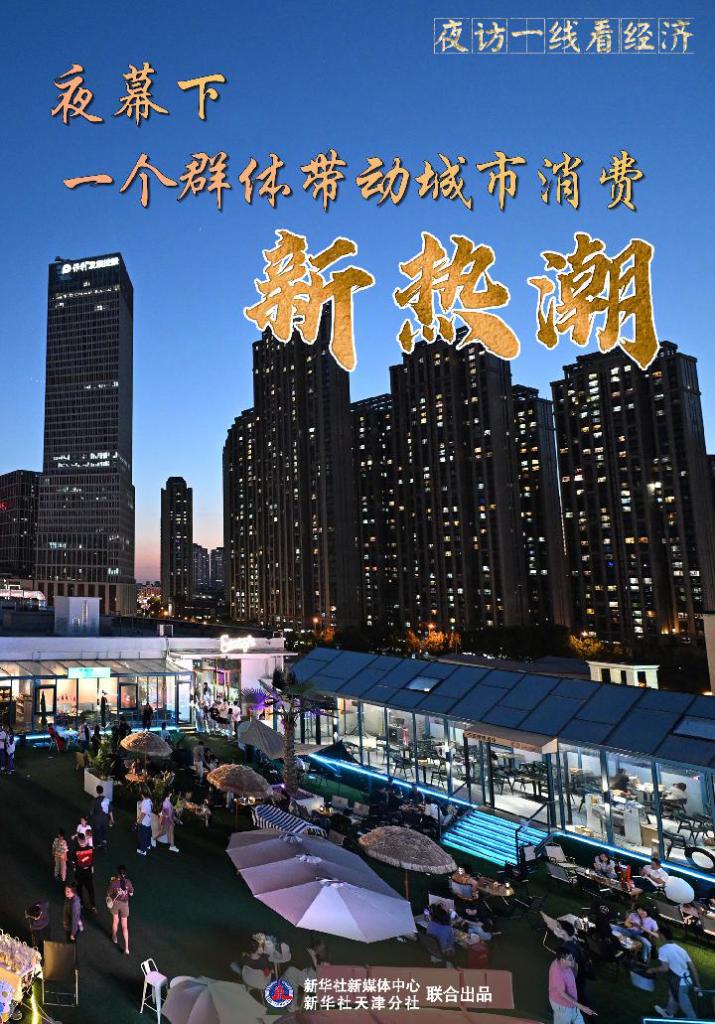
Poster production: Fang Jinyang
Xinhua News Agency, Tianjin, June 9 (Reporter Guo Fangda, Song Rui) Put up shelves, hang up the slogan of "Micro Store", and decorate small colored lights around to create an atmosphere … … As night falls, the RV camping park in Qihe Village, Zhongtian, Tianjin is gradually becoming lively.
"Every weekend night, there are more than 70 stalls in the park, and the goods are dazzling." Bin Chen, head of the camping park, said. This kind of market has low operating costs and flexible venues, and has become an exchange platform for many young people to display personalized creative products, hand-made and fashionable products.
Xu Yan, a 30-year-old "office worker", used her spare time to "micro-start a business" to run a small handmade jewelry business in a night market. Xu Yan told reporters that many friends around her couldn’t hold back and became "small bosses" in the night market.
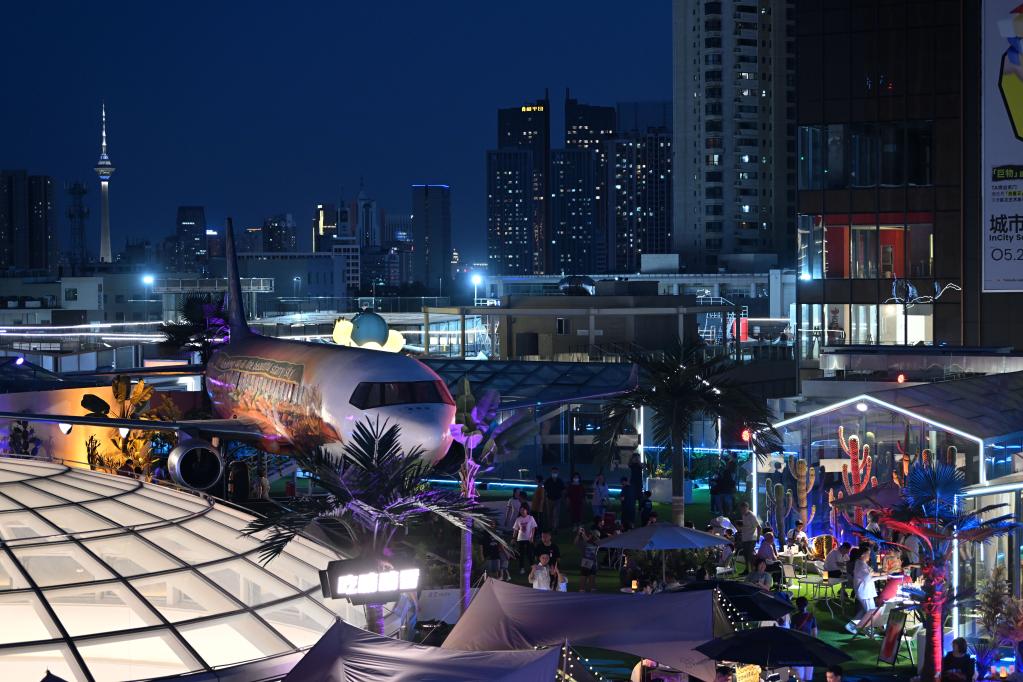
In Impression City, Jinjie Business Circle, Heping District, Tianjin, this is the "airplane" theme bar on the roof. Xinhua News Agency reporter Li Ran photo
The 14th Five-Year Plan for Cultural Development proposes to "promote cultural consumption in an all-round way, speed up the development of new cultural consumption patterns and develop night economy".
From traditional barbecue snacks to novel urban camping experience, the flow of people along the Tianta Lake, one of Tianjin’s landmark buildings, is increasing.
"New sports such as Frisbee and All-Armored Fighting are the key projects for our investment negotiation." Ma Teng, head of Tianta Lake camping night market project, said that consumers are not only satisfied with filling their stomachs, but also rich consumption scenes can attract more people.
A number of new formats, such as interactive drama catering and cultural teahouse, are one of the early adopters for young consumers. "Many young people regard their hobbies as ‘ Micro-entrepreneurship ’ The means not only enriches the service form, but also stimulates actual consumption. " Ma Teng said.
Before the meal, I extracted my identity from the blind box, interacted with the actors during the meal to become a "person in the play", and tasted the market culture of Tianjin from the play and the plate. The "a good play" of Tianjin Impression City Old Wharf Restaurant recently attracted many guests.
"Integration is the key." Jing Wong, project manager of Tianjin North Performing Arts Group’s Business (Cultural Travel) Development Center, said, "We tell about Tianjin’s food culture in the form of drama, and many viewers are very much looking forward to what kind of food they will eat in the drama. At the same time, through the live with the actors ‘ Dragging ’ Diners can enjoy a feast of sight, hearing and taste. "
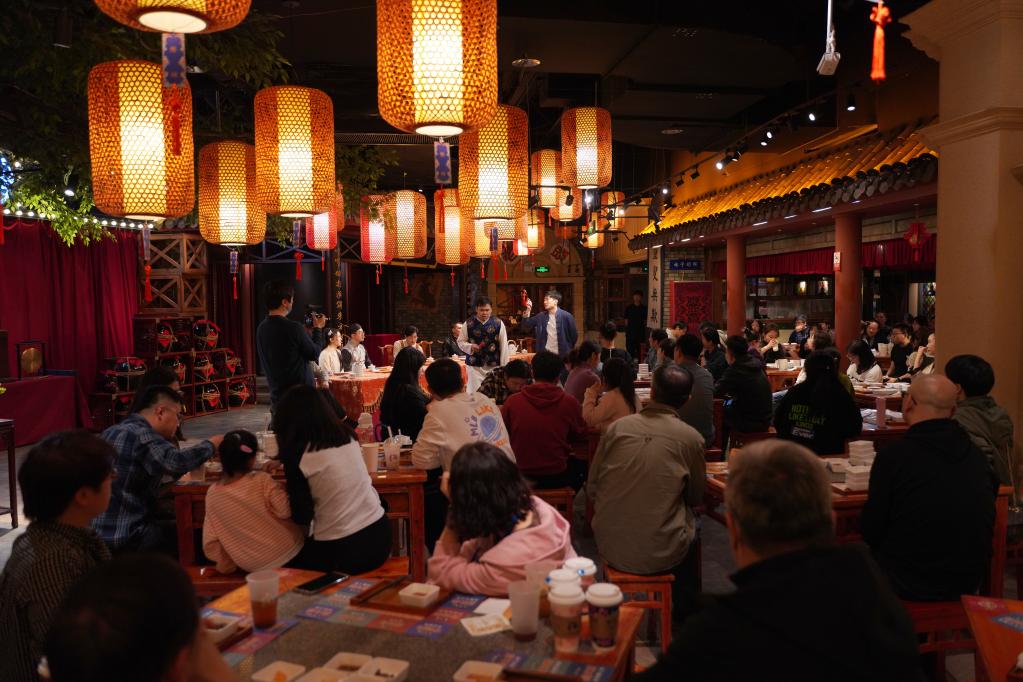
The audience enjoyed the interactive drama "Old Wharf Inside and Outside the Play". (Xinhua News Agency)
One is consumption, and the other is employment. The relationship between night economic vitality and employment can be seen from the data.
Cloud Account (Tianjin) Sharing Economic Information Consulting Co., Ltd. provides flexible employment services such as industrial and commercial tax agency, income verification and settlement, commercial insurance protection, etc. for more than 84 million workers with new employment forms, and a considerable part of the settlement takes place at night.
"In May of this year, the number of settlement people in cloud accounts at night (from 20: 00 to 24: 00) accounted for 27% of the whole day, of which 24: 00 settlement people accounted for 6%, which was one of the peaks of the whole day." Yang Hui, chairman of the enterprise, believes that the continuous enrichment of new employment forms is just an echo of the emerging consumer demand.
The "pulse" of night consumption is inseparable from urban characteristics. For example, Datang City, Xi ‘an, relies on cultural tourism resources to build a business matrix along the street, and many catering and cultural and creative brands have settled in, which has formed a sustainable "culture+"block. Nanjing’s Qinhuai River, Confucius Temple, Ming City Wall, Jiangnan Gongyuan and other cultural resorts complement each other, forming a unique landscape with a thousand-year-old charm and modern commerce.
"The development of night economy needs a breakthrough ‘ One side of a thousand cities ’ Deeply cultivate new models, new scenarios and new formats. " Gao Nan, a professor at Tianjin University of Finance and Economics, believes that with the injection of diversified forces, the night consumption market in various places will become more prosperous, and more cities will find the development code of organic integration of night economy and urban culture.
The comprehensive fuel consumption is less than 6 liters! GAC Toyota VIA, the hybrid power is fragrance.
[Pacific Auto Network Evaluation Channel] In Toyota’s SUV camp, the compact SUV Willanda (parameter picture) can be called sales, while for multi-member families, there is Highlander, which is also a benchmark model. Weisha (inquiry base price | inquiry and matching) is aiming at the gap between the two, focusing on five boutique labels in the city. It has a certain cross-border SUV style, a more fashionable temperament than Willanda, and a lower cost of materials and configuration. The pricing is also higher, and the top price of dual-engine four-wheel drive has exceeded 300,000. So today, let’s discuss, what is the driving experience and performance of the dual-engine version of VISA?
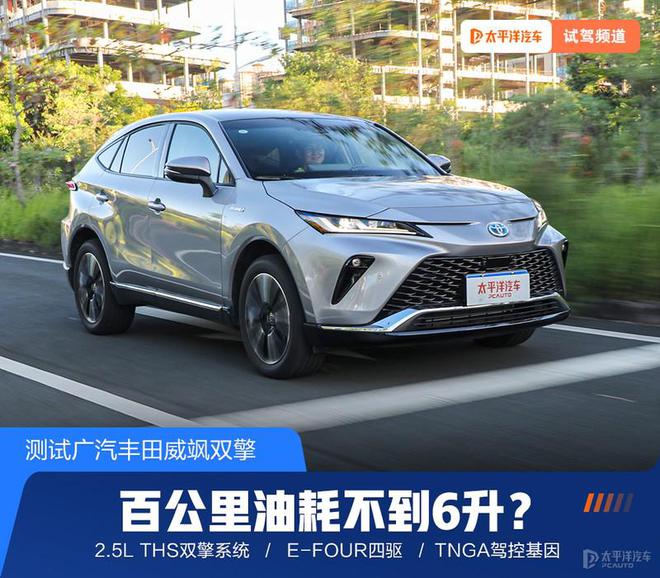
Dynamic feeling
Like other Toyota models, VISA provides gasoline version and hybrid version. We experience the dual-engine hybrid four-wheel drive version. The parameters of the engine and front and rear drive motors are as follows. The total power of the system is 163kW, and the total torque is not officially announced (the total power of the two-wheel drive version is 160kW). The transmission is a hybrid E-CVT, and the drive is also an E-FOUR electronic four-wheel drive system without a transmission shaft. The rear wheels are directly driven by the rear axle motor.
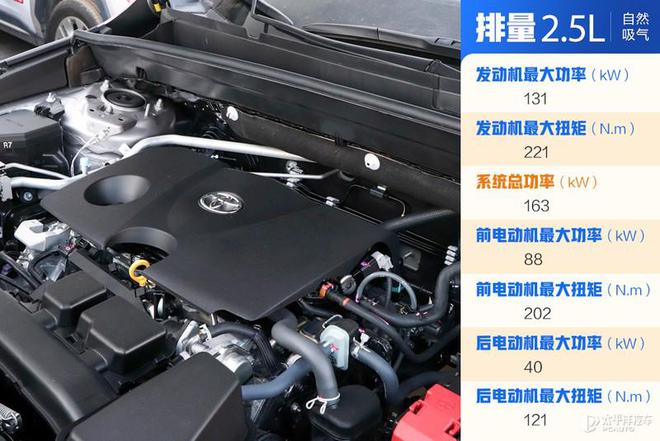
This fourth-generation THS II hybrid system is familiar to everyone, and it is composed of 2.5L Atkinson cycle naturally aspirated fuel engine, E-CVT electronic continuously variable shifting mechanism, battery pack and PCU energy control system. This system has been applied to high-end Toyota models on TNGA-K platforms such as Camry, Willanda and Highlander.
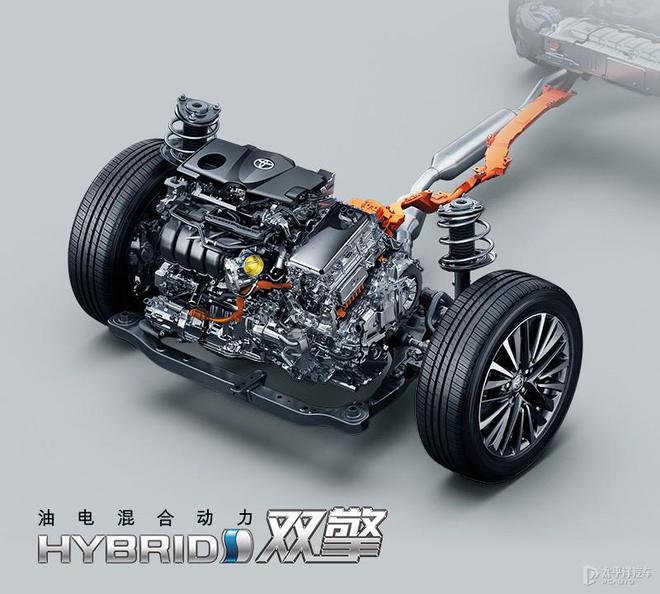

A detailed introduction of the 2.5L dual-engine hybrid system should be at least worded. Fortunately, we have made a detailed interpretation of this system before. If you are interested, you can click on the picture below to jump to the relevant links to learn more about Toyota as a "hybrid master". In this paper, we will focus on the actual driving experience and performance of VISA.

At the beginning, VISA only relies on the motor to drive, which can not only avoid the inefficient working condition of the engine, but also realize the lightness and quietness of the tram with the large torque of the motor. When you step on the accelerator deeply, the engine will start, output power with the motor and replenish energy for the battery.
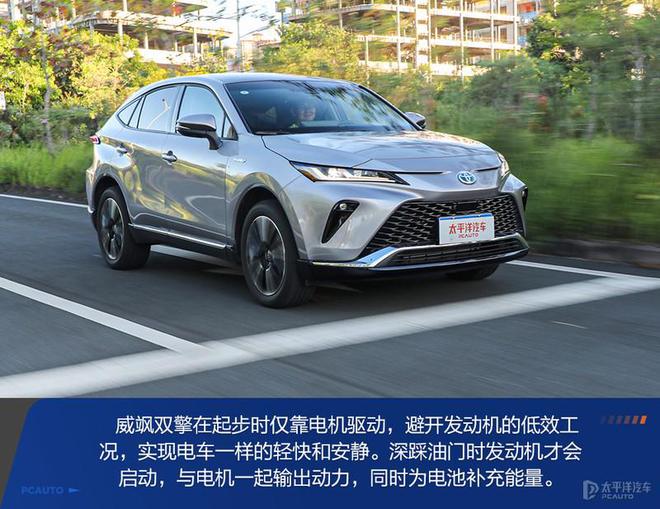
As for the driving modes of ECO, NORMAL and SPORT, the difference between them is simply that the involvement of the engine is different. In the ECO economic mode, the system will use pure electric driving as much as possible, and the engine will not be involved unless necessary, so the power is relatively soft. In SPORT sports mode, the engine will wake up immediately when the throttle is lightly stepped on, and the speed is easier to soar, making driving more enjoyable.
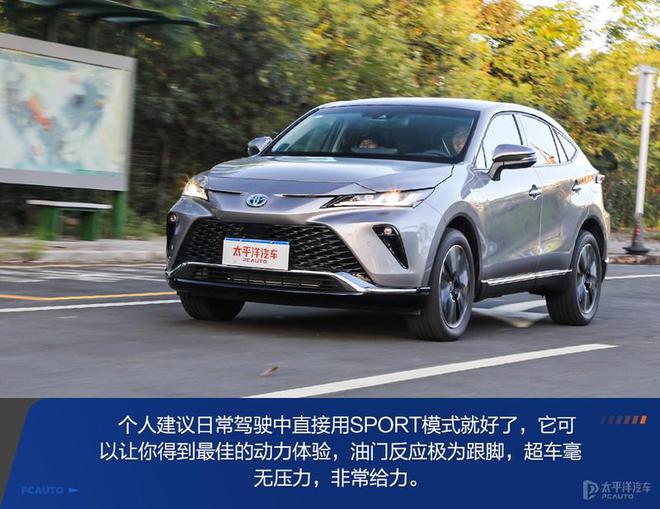
There is also an EV mode button on the car. You can force the system to enter EV mode until the power is low. Of course, if you suddenly get a foot of floor oil, the system will not hesitate to hit the engine to return all the power.
Personally, I suggest using SPORT mode directly in daily driving, and don’t worry that the fuel consumption of sports mode will be much higher. After all, you don’t have floor oil on every foot, right? Sport mode allows you to get faster speed-up ability under the same throttle opening. The dual-engine system is still highly efficient, and the fuel consumption of hybrid vehicles in sport mode will not increase as much as that of fuel vehicles.
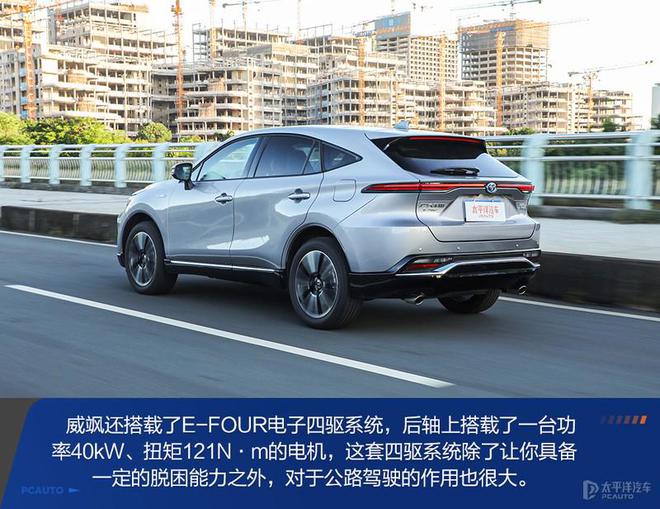
When the vehicle starts, the E-FOUR four-wheel drive system will let the rear wheels output power, which effectively reduces the situation that the front-wheel vehicle starts with heavy tail and light start, and makes the start more rapid and stable. In the case of acceleration, ramp, wet and slippery road, the system can instantly enter the four-wheel drive state, and the torque distribution of the front and rear wheels can be automatically adjusted between 100: 0 and 20: 80. In other words, Toyota’s electronic four-wheel drive system is very helpful for daily driving, not just for you to cope with off-road conditions.
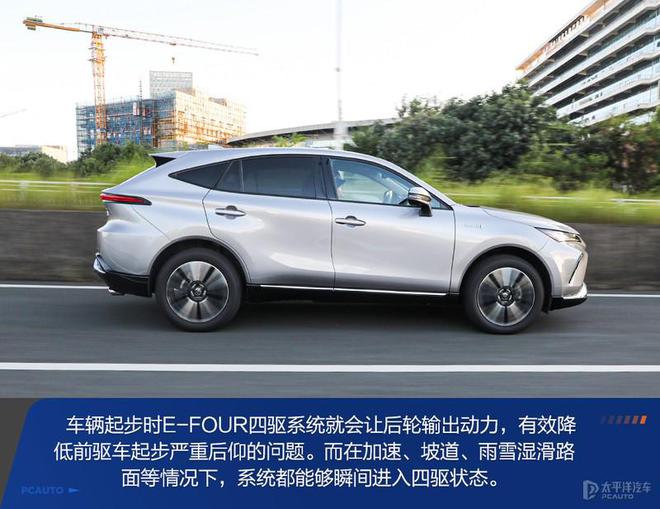
Toyota TNGA has the characteristics of low center of gravity. Although it is an SUV, VISA also has this gene. In addition, it has sensitive steering response, balanced feedback and relatively good suspension support. When driving fiercely, it is very comfortable to control, as if driving a small hatchback steel gun.
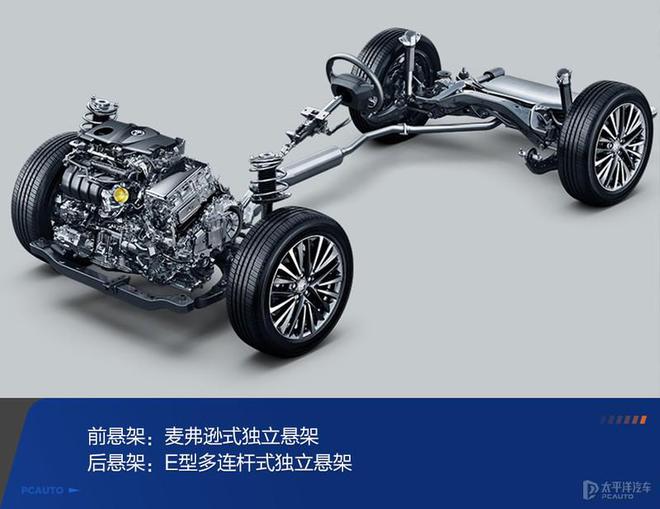
Weisa’s chassis adopts a four-wheel independent suspension structure with E-shaped multi-link before McPherson. This suspension is flexible in the middle and tough in the middle, which can effectively filter out the small bumps on the unpaved pavement. When encountering large pits and ditches, the shock absorber can absorb the impact well, and the rebound is very crisp and comfortable.
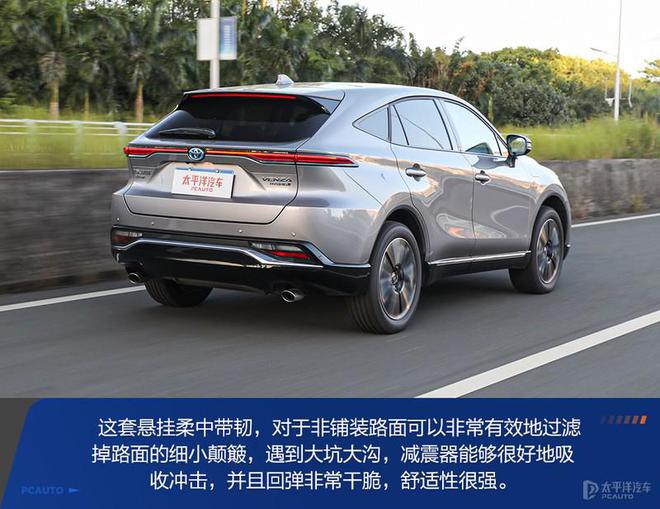
However, as an urban SUV with family orientation, its suspension will naturally not be adjusted to be very tough, so there will still be a certain roll when cornering quickly. Although its handling limit is not low, when full of passengers, it is better to press the speed when cornering.
Regarding other static information such as shape, interior and space, we have made a special analysis before, and the picture below the motor can go to the relevant page, so I won’t repeat it here.

Fuel consumption test
Dual-engine hybrid models, fuel consumption performance is naturally the highlight. The VIA we tested is a four-wheel drive version, so what is its comprehensive fuel consumption performance?
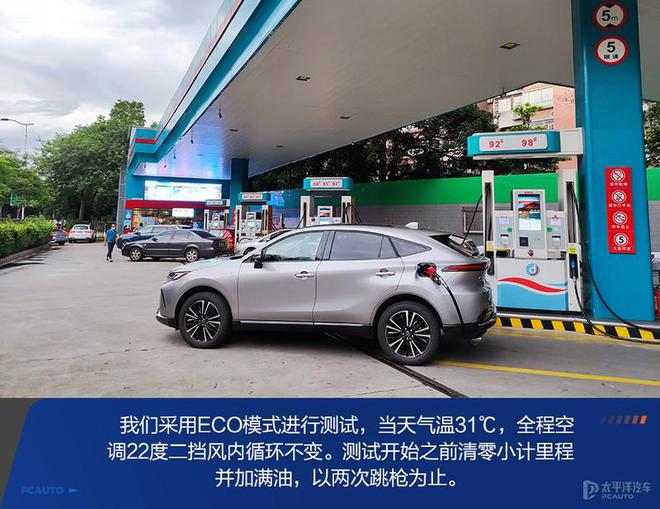
We used ECO mode to test, the temperature was 31℃ that day, and the internal circulation of air conditioner was unchanged at 22 degrees during the whole process. Before the test starts, clear the subtotal mileage and fill it with oil until it jumps twice. The test route traveled a total of 185.1km, with most expressways, and the overall road conditions were relatively smooth. However, due to a serious traffic accident on the expressway, it was congested for a whole hour, and the congestion level has reached the point of long-term stop and low-speed crawling. That is to say, the whole fuel consumption test process is a comprehensive working condition including high-speed cruising, low-speed stop-and-go and long-time parking and idling.
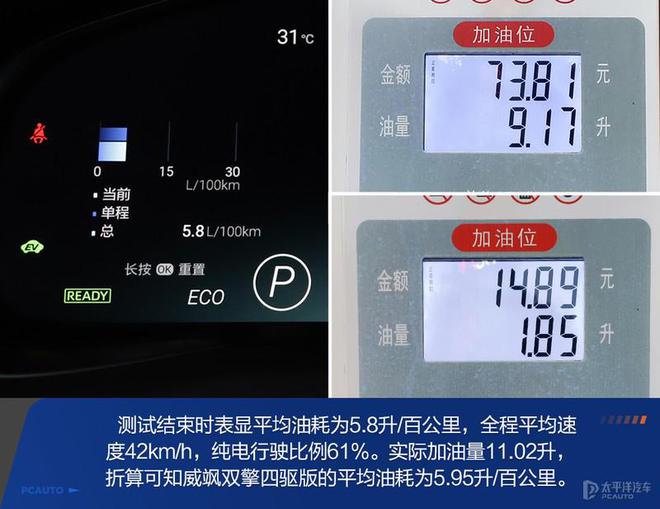
At the end of the test, the fuel consumption is 5.8 liters/100 kilometers, the average speed is 42km/h, and the proportion of pure electric driving is 61%. At the end of the test, we refilled the car with oil, or we jumped the gun twice. The actual fuel consumption is 11.02 liters. After conversion, the average fuel consumption per 100 kilometers of the VISA dual-engine four-wheel drive version is 5.95 liters. This fuel consumption performance is quite good for a four-wheel drive SUV with a large size.
Accelerated test
Before the acceleration test, we need to turn off the ESP and air conditioner, and turn on the sports mode to let the vehicle enter the strongest power state. We start by holding the speed. Because the Toyota twin-engine model doesn’t directly display the speed, we can’t know the maximum speed, but because of the protection procedure, its speed will naturally not be very high. In short, the system is in a state of full output of the engine and motor at the moment of starting.
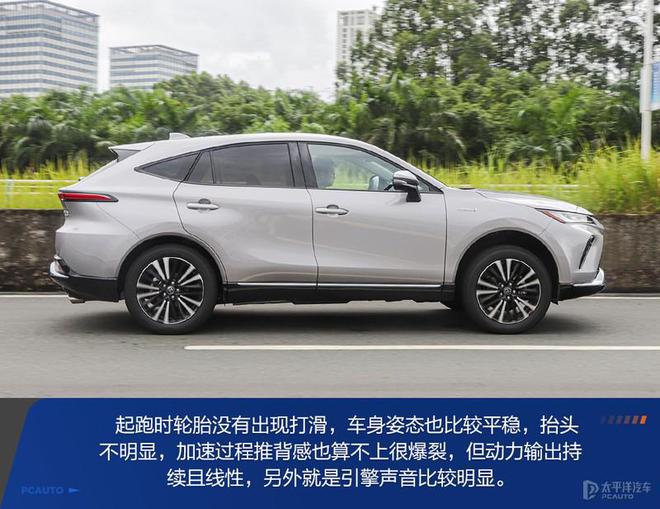
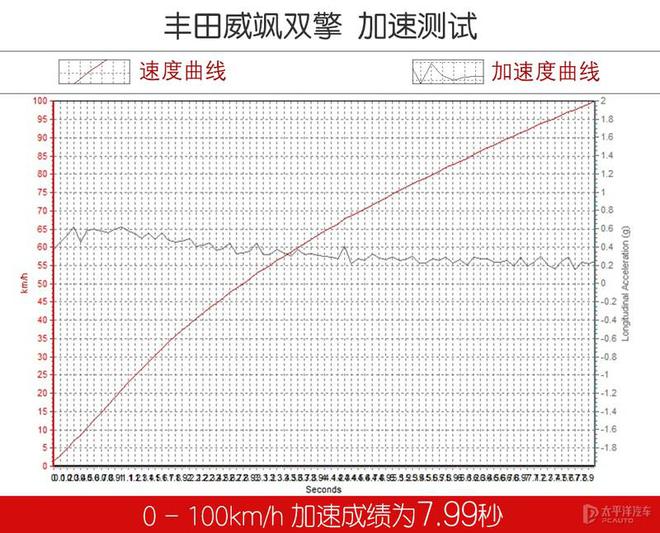
Judging from the acceleration curve, the engine and the motor are working in parallel at the moment of starting, and the acceleration can reach 0.6g, which is still quite powerful, but it soon begins to fall back, and the G value is basically maintained at 0.2g after the speed is 70 km/h.
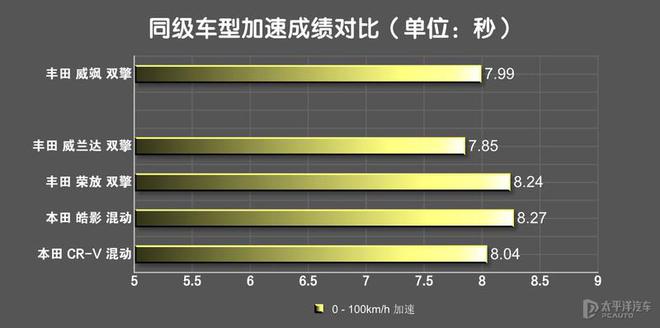
With the positioning of VIA twin engines, there is no particularly equivalent model in the market. We take other Japanese hybrid compact SUVs as a reference. Considering that the test environment is not completely unified and there may be some errors in the test, VIA’s score of 7.99 seconds can be regarded as at the same level as other cars.
Brake test
In the braking test, we stepped on the brake at a speed of 100km/h until it stopped. During the whole test, the braking force was very in place, the output was relatively linear, and the front suspension also provided relatively in-place support. In addition, the foot feel of the brake pedal is relatively uniform, and there will be no obvious phenomena of soft front and tight back, virtual front and solid back. The ABS anti-lock braking system intervened in time, the body posture was relatively stable, and there was no serious lateral swing at the rear.
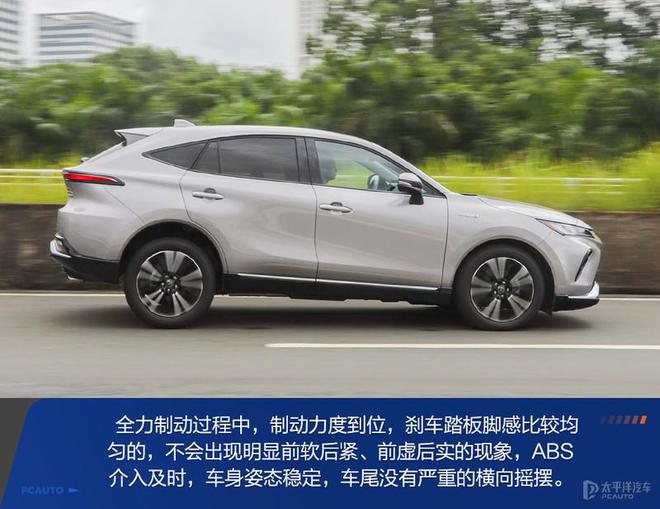
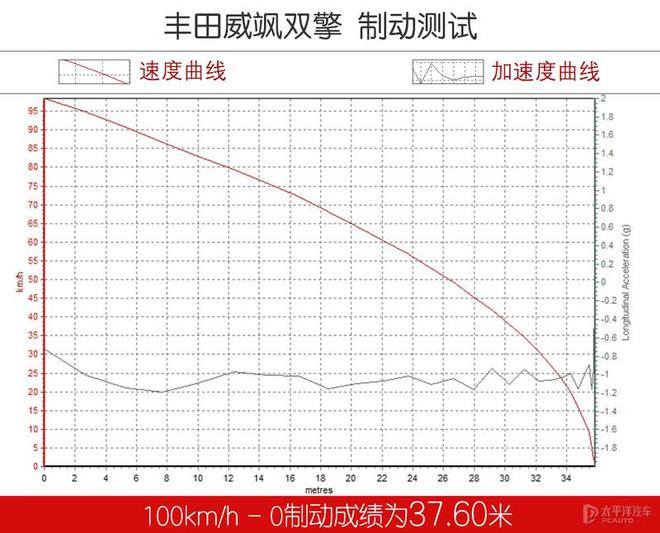
It can be seen from the chart that during the whole braking process, the braking force appears a short rising stage in the initial stage, and then the acceleration basically remains around-1.1g.. Compared with other hybrid compact SUVs, the score of 37.60 meters is also one of the best.
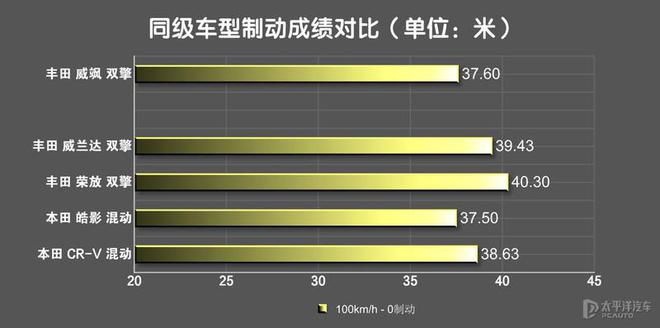
Pile winding test
The test around the pile is a test for the steering accuracy, dynamic response, chassis support and tire grip of the vehicle. According to the actual experience, the ultimate speed around the pile is about 70 km/h. Of course, this limit speed is also affected by the site conditions, tire conditions and drivers. Generally speaking, as an SUV, the handling performance of VISA is quite good.
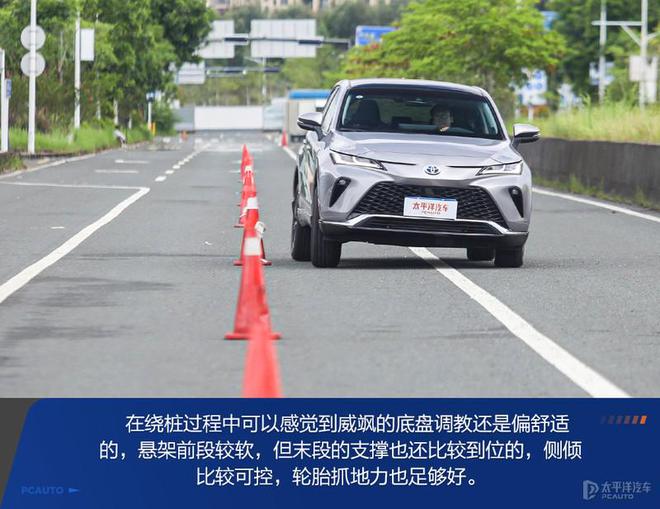
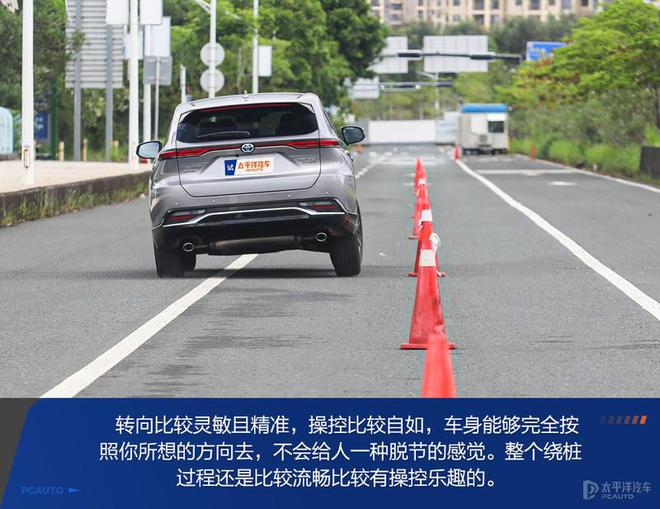
In addition, the steering around the pile is relatively hand-to-hand, which makes it easier to control, and the body can go in the direction you want completely, without giving people a sense of disconnection. Thanks to the motor assistance with better explosive torque, it is easier to keep the speed around the pile, and the speed can be raised as soon as the oil is fed, so the whole process is relatively smooth and interesting to control.
Noise test
We tested that the Extreme Edition of VISA Dual-engine Four-wheel Drive is equipped with a front sound insulation glass. After turning off any functions that may make noise, such as air conditioning, stereo and seat ventilation, we measured that the minimum stable value of the noise inside the car was 33.9 dB when the engine was turned off. At this time, the ambient noise outside the car is 48.6 decibels, which effectively isolates the noise outside the car. When the engine starts running, its noise is more obvious, reaching 47.7 decibels, which is close to the ambient noise outside the car.
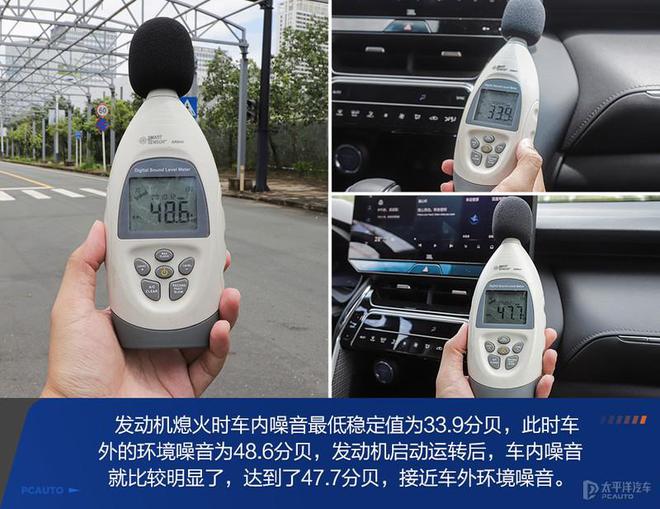
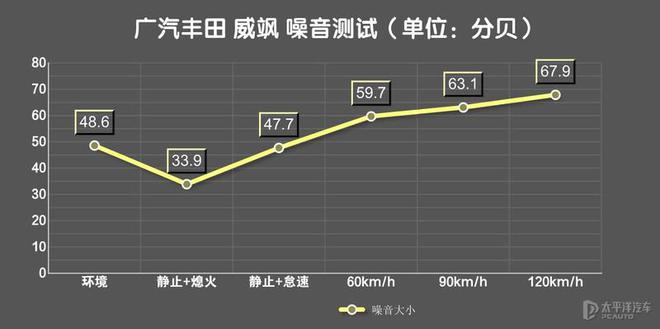
As the speed increases, the noise inside the car naturally increases. At the three speeds of 60km/h, 90km/h and 120km/h, the interior noise values are 59.7 dB, 63.1 dB and 67.9 dB respectively. The noise test is also affected by the site environment, wind speed and the error of the noise meter itself, but the sound insulation level of VISA is good compared with the previous models tested by the same noise meter in the same site.
Total knot
Generally speaking, there is not much difference in the performance of VISA because it is equipped with the same dual-engine power system as Willanda. However, as a model with higher positioning, VIA has indeed created a higher texture in terms of design style and interior materials, and has a more sporty adjustment in terms of handling. If you are a consumer who pursues high quality and there is no demand for seven seats at the same time, then with a budget of 300,000, VISA is just right for you! (Photo/Text/Photo: Pacific Ocean)
Comparison of vehicle parameter configuration
● Standard ○ Optional-No model picture: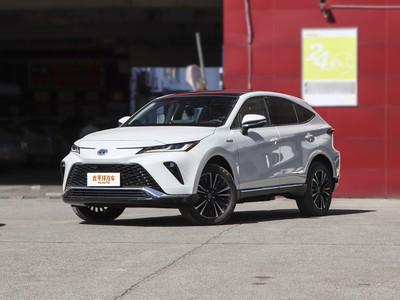
Vehicle information:Weisa
Section 2022
Dual-engine 2.5L E-CVT Four-wheel Drive Extreme EditionOfficial price: 303,800 yuan purchase tax: 26,900 yuan final landing price (including insurance money): 342,700 yuan energy consumption (20,000 kilometers/year):-Manufacturer: GAC Toyota Grade: medium SUV time to market: 2022-01 Engine: 2.5L L4 air intake form: naturally aspirated maximum horsepower (PS): 178 maximum torque (N m : 128 total torque of motor (n m): 323 battery charging time: 323 fast charging amount (%):-gearbox: E-CVT continuously variable body type: 5-door 5-seat SUV length× width× height (mm): 4780× 1855× 1660 wheelbase (mm): 2690 maximum speed (km) -Measured braking at 100-0km/h (m):-Measured fuel consumption (L/100km):-Measured pure electric cruising range (km):-Measured fast charging time (hours):-Measured slow charging time (hours):-Measured power consumption per 100 km (kWh/100 km):-Measured vehicle speed of 0km/h.: 5WLTC comprehensive fuel consumption (L/100 km):-CLTC comprehensive fuel consumption (L/100 km):-Battery warranty time: unlimited years/unlimited mileage for the first owner (the exemption clause is subject to the official): NEDC pure electric cruising range (km):-WLTP pure electric cruising range (km):-CLTC pure electric cruising range (km):- :-Charging time:-Vehicle warranty: three years or 100,000 kilometers. First owner warranty policy:-Driver assistance level: L2 Body type: SUV length (mm): 4780 width (mm): 1855 height (mm): 1660 wheelbase (mm): 2690 front track (mm): 1607 rear track (mm) : 5 seats (units): 5 fuel tank volume (L): 55 luggage compartment volume (L):-Maximum luggage compartment volume (L):-Internal luggage compartment size (mm):-Cargo compartment size (mm):-Maximum load mass (kg):-Engine model: A25D displacement (mL): 2487 intake mode. : 5700 Maximum torque (n m): 221 Maximum torque and speed (rpm): 3600-5200 Cylinder arrangement: number of in-line cylinders (units): 4 number of valves per cylinder (units): 4 Compression ratio: 14 Valve train: DOHC cylinder diameter (mm): 87.5 stroke (mm): 103.4 Engine specific technology: VVT-iE/VVT-i fuel form: gasoline-electric mixed fuel label: No.92 (formerly No.93) fuel supply mode: mixed injection cylinder head material: aluminum alloy cylinder block material: aluminum alloy emission standard: national VI motor model:- : 174 total motor power (kW): 128 total motor torque (n m): 323 maximum motor power (kw): 88 maximum motor torque (n m): 202 maximum motor power (kw): 40 maximum motor torque (n m): 121 drive mode: non-plug-in hybrid drive motor. : 163 system comprehensive torque (n m):-NEDC pure electric cruising range (km):-WLTP pure electric cruising range (km):-CLTC pure electric cruising range (km):-EPA pure electric cruising range (km):-Official power consumption per 100 kilometers (kWh/100 km):-Battery capacity (kWh):-. -battery type: ternary lithium battery warranty time: the first owner has unlimited years/unlimited mileage (the exemption clause is official) battery charging time: the first owner has unlimited years/unlimited mileage (the exemption clause is official) fast charging amount (%)-abbreviation: E-CVT continuously variable gear number:-gearbox type: electronic continuously variable gearbox (E-CVT) Driving mode: front four-wheel drive four-wheel drive form: electric four-wheel drive central differential structure:-front suspension type: McPherson independent suspension rear suspension type: E-type multi-link independent suspension steering assist type: electric moped body structure: load-bearing front brake type: ventilated disc rear brake type: disc parking brake type: electronic parking front tyre size: 225/55 R19 rear tyre size: 225/ 55 R19 spare tire specification: non-full-size spare tire size:-approach angle ():-Departure angle ():-Longitudinal passing angle ():-Maximum climbing degree (%)/climbing angle ():-Minimum ground clearance (mm):-Minimum turning radius (m): 5.7 Maximum wading depth (mm). : ● Traction control (ASR/TCS/TRC, etc.): ● Body stability control (ESP/DSC/ESC, etc.): ● Tire pressure monitoring device: tire pressure display explosion-proof tire:-Safety belt unbuttoned prompt: front row merging assistance: ● Lane departure warning system: ● Lane keeping assistance system: ● Active braking/active safety system: ● Road traffic sign recognition:-Fatigue driving prompt.: Front ●/Rear ● Front knee airbag: main ●/deputy-passenger seat cushion airbag:-Front center airbag:-Rear seat anti-sliding airbag:-Pedestrian collision protection system: -ISO FIX child seat interface: ● Engine electronic anti-theft: ● Central locking in the car: ● Key type: remote key driving automatic locking: ● Remote lifting window: ● Remote start:- Rear radar: front ●/rear ● Parking image system: 360-degree panoramic image: car side blind spot image system:-Dynamic reversing reminder system: ● Driving mode switching: standard/comfortable.
economy
Automatic parking in motion:-Engine start-stop technology:-Automatic driving assistance:-Uphill assistance: ● Automatic parking: ● Steep descent:-Variable suspension:-Electromagnetic induction suspension:-Air suspension:-Variable steering ratio:-Integral active steering system:-Front axle limited slip differential/differential lock:-Central differential locking function:-Rear axle limited slip differential/differential lock:. :-Sports appearance kit:-Aluminum alloy wheel hub: ● Electric spoiler:-Electric suction door:-Frameless design door:-Electric trunk: ● Induction opening of trunk: ● Position memory of electric trunk: ● Roof rack:-Hidden electric door handle:-Active air intake grille:-Steering wheel material: leather steering wheel adjustment range: up and down+front and rear steering wheel electric adjustment:-Multifunctional steering wheel: ●
Multimedia information full LCD instrument panel: ● LCD instrument panel size: 12.3 inch HUD head-up digital display: ● Car driving recorder:-Mobile phone wireless charging: front seat material: imitation leather+leather sports style seat:-Front seat height adjustment: front seat cushion inclination adjustment: front seat lumbar support adjustment: front seat shoulder support adjustment:-main/co-pilot seat electric adjustment: main ●/ Deputy ● Rear seat of the passenger seat is electrically adjustable:-Rear seat adjustment: backrest adjustment Rear seat electric adjustment:-Electric seat memory: steering wheel of the driver’s seat/comfortable entry and exit of the seat:-Front/rear seat heating: front ●/rear-front/rear seat ventilation: front ●/rear-front/rear seat massage: front-/rear-rear seat reclining form: the third row of seats is reclined proportionally. Rear ● Rear cup holder: ● Air conditioning adjustment mode: automatic temperature zoning control: dual-zone rear independent air conditioning:-rear seat air outlet: ● PM2.5 filter in the car: ● car air purifier: ● Negative ion generator: ● car refrigerator:-low beam light source: LED high beam light source: LED adaptive distance light: ● daytime running light: ● automatic headlights: ● steering auxiliary light:-follow-up steering headlights.:-Front fog lamp: rain and fog mode of headlights:-Headlight height can be adjusted: ● Headlight cleaning device:-Headlight is turned off in a delayed manner:-Touch reading lamp:-Interior ambient light: ○ Electric window: one-button up/down of the whole car window: anti-pinch function of the whole car window: multi-layer sound insulation glass of the whole car: ultraviolet protection of the front window/ Thermal insulation glass:-Electric adjustment of rearview mirror: ● Heating of exterior rearview mirror: ● Electric folding of rearview mirror: ● Automatic folding of rearview mirror when locking the car: ● Automatic turning-down of rearview mirror when reversing: ● Memory of rearview mirror: ● Automatic anti-glare of interior/exterior rearview mirror: streaming function of interior/exterior-interior rearview mirror: ● Rear windshield sunshade:-Rear side sunshade:-Rear side privacy glass: ● Sunvisor makeup mirror: main driver.
Co-pilot+rear wiper of floodlight: ● Induction wiper: ○ color large screen of center console: ● Large screen size of center console: 12.3 inches. Operation mode of center console: touch-sensitive satellite navigation system: ● Real-time traffic information display: ● Mobile phone interconnection/mapping:-car networking: ●OTA remote online upgrade: road rescue call: ● Voice recognition control system: multimedia system.
navigate
telephone
air conditioner
Skylight gesture control:-Bluetooth/car phone: ● Central control LCD screen display:-Car TV:-Rear LCD screen:-Rear central control system:-Interface type: USB
AUX
Number of Type-CUSB/Type-C interfaces: standard: 3, Optional: 2220V/230V power supply:-12V power supply interface of trunk: -CD/ DVD:-Speaker brand: JBL speaker quantity: standard: 9 active noise reduction system:-System name: Toyota Safety Sense autopilot chip:-Chip computing power:-Number of cameras:-Millimeter wave radar:-Ultrasonic radar:-Lidar:-Automatic lane change:-Corner keeping assistance:-Navigation assistance driving:-Built-in high-precision map:-Obstacle visual display:- Drive-out:-Remote call:-Car system:-Face recognition: ● Fingerprint recognition:-Processor:-Number of central control screens:-Screen resolution:-Screen rotation:-Multi-screen interaction:-Voice recognition:-Multi-round voice dialogue:-Fuzzy semantic recognition:-Remarks:-Fast track: understanding dealer quotation > >
Enter the car channel > > More car comparison > >
The Central Bank released the Report on Financial Statistics for the First Three Quarters of 2017.
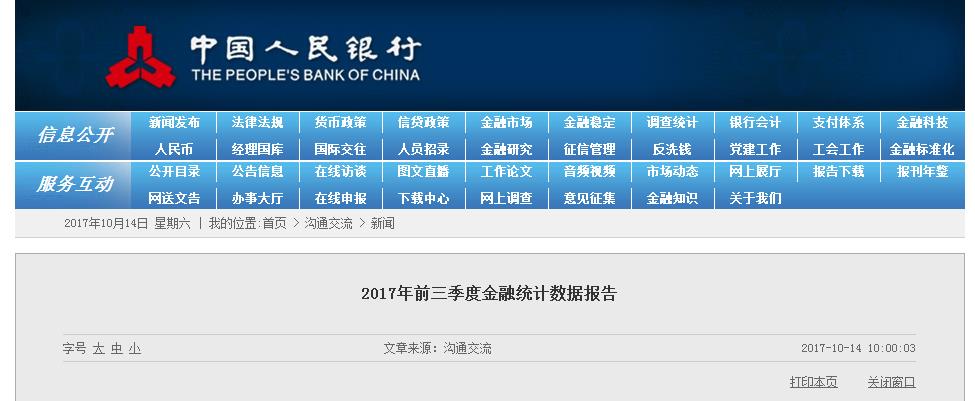
Cctv newsAccording to the website of the People’s Bank of China, at the end of September, the balance of broad money (M2) was 165.57 trillion yuan, up 9.2% year-on-year, and the growth rate was 0.3 percentage points higher than the end of last month and 2.3 percentage points lower than the same period of last year. The balance of narrow money (M1) was 51.79 trillion yuan, up 14% year-on-year, and the growth rate was the same as the end of last month, 10.7 percentage points lower than the same period of last year. The balance of money in circulation (M0) was 6.97 trillion yuan, a year-on-year increase of 7.2%. In the first three quarters, the net cash input was 144.5 billion yuan.
In the first three quarters, RMB loans increased by 11.16 trillion yuan and foreign currency loans increased by 30.5 billion US dollars.
At the end of September, the balance of local and foreign currency loans was 123.18 trillion yuan, a year-on-year increase of 12.5%. At the end of the month, the balance of RMB loans was 117.76 trillion yuan, up 13.1% year-on-year. The growth rate was 0.1 percentage point lower than that at the end of last month and 0.1 percentage point higher than that at the same period of last year.
In the first three quarters, RMB loans increased by 11.16 trillion yuan, a year-on-year increase of 998 billion yuan. In terms of sectors, loans to households increased by 5.73 trillion yuan, of which short-term loans increased by 1.53 trillion yuan and medium-and long-term loans increased by 4.2 trillion yuan; Loans from non-financial enterprises and government organizations increased by 5.73 trillion yuan, of which short-term loans increased by 1.72 trillion yuan, medium-and long-term loans increased by 5.51 trillion yuan, and bill financing decreased by 1.72 trillion yuan; Loans from non-banking financial institutions decreased by 296.3 billion yuan. In September, RMB loans increased by 1.27 trillion yuan, a year-on-year increase of 56.6 billion yuan.
At the end of September, the balance of foreign currency loans was US$ 816.3 billion, a year-on-year increase of 1.5%. In the first three quarters, foreign currency loans increased by $30.5 billion, an increase of $56.4 billion year-on-year. In September, foreign currency loans decreased by $16.4 billion, a year-on-year decrease of $11.2 billion.
In the first three quarters, RMB deposits increased by 11.68 trillion yuan and foreign currency deposits increased by 61.5 billion US dollars.
At the end of September, the balance of local and foreign currency deposits was 167.42 trillion yuan, a year-on-year increase of 9.5%. At the end of the month, the balance of RMB deposits was 162.28 trillion yuan, up 9.3% year-on-year. The growth rate was 0.3 percentage points higher than the end of last month and 1.8 percentage points lower than the same period of last year.
In the first three quarters, RMB deposits increased by 11.68 trillion yuan, a year-on-year decrease of 1.13 trillion yuan. Among them, household deposits increased by 4.48 trillion yuan, non-financial enterprises increased by 2.03 trillion yuan, fiscal deposits increased by 789.2 billion yuan, and non-banking financial institutions increased by 1.24 trillion yuan. In September, RMB deposits increased by 433.2 billion yuan, a year-on-year increase of 433.8 billion yuan.
At the end of September, the balance of foreign currency deposits was US$ 774.5 billion, a year-on-year increase of 16.4%. In the first three quarters, foreign currency deposits increased by $61.5 billion, an increase of $23.7 billion year-on-year. In September, foreign currency deposits decreased by $13.1 billion, a year-on-year decrease of $30.7 billion.
In September, the monthly weighted average interest rate of interbank lending in RMB market was 2.92%, and the monthly weighted average interest rate of pledged bond repurchase was 3.07%.
In the first three quarters, the inter-bank RMB market traded a total of 580.12 trillion yuan by means of borrowing, cash coupons and repurchase, with an average daily turnover of 3.07 trillion yuan, which decreased by 8.5% compared with the same period of last year. Among them, the average daily turnover of interbank lending decreased by 22.9% year-on-year, the average daily turnover of cash bonds decreased by 21.6% year-on-year, and the average daily turnover of pledged repo decreased by 2.2% year-on-year.
The weighted average interest rate of interbank lending in September was 2.92%, which was 0.05 percentage points lower than last month and 0.67 percentage points higher than the same period of last year. The weighted average interest rate of pledged repo was 3.07%, 0.02 percentage points lower than last month and 0.79 percentage points higher than the same period of last year.
The balance of China’s foreign exchange reserves is 3.11 trillion US dollars.
At the end of September, the balance of China’s foreign exchange reserves was $3.11 trillion. At the end of September, the RMB exchange rate was 6.6369 yuan to 1 US dollar.
In the first three quarters, RMB settlement of cross-border trade amounted to 3.23 trillion yuan, and RMB settlement of direct investment amounted to 962.3 billion yuan.
In the first three quarters of 2017, cross-border trade in goods, trade in services and other current accounts, foreign direct investment and foreign direct investment settled in RMB amounted to 2.41 trillion yuan, 823 billion yuan, 246.9 billion yuan and 715.4 billion yuan respectively.
Note 1: Current data are preliminary.
Note 2: Since October 2011, the money supply has included deposits from the housing provident fund center and deposits from non-deposit financial institutions in deposit financial institutions.
Note 3: Since August 2014, entrepot trade has been adjusted to goods trade for statistics, and the amount of goods trade has expanded, while the amount of service trade has decreased accordingly.
Note 4: Since 2015, RMB, foreign currency and local and foreign currency deposits include deposits from non-banking financial institutions, while RMB, foreign currency and local and foreign currency loans include loans to non-banking financial institutions.
The 50th anniversary of the release of Abbey Road, returning to the Beatles’ fanaticism.
Commemorating the 50th anniversary of the publication of Abbey Road

London, England, 1964
? David Hurn | Magnum Photos
In the era when the Beatles were the most popular, who didn’t think about what it would be like to keep "mop head"?
John Lennon, Paul McCartney, George Harrison and Ringo Starr have also been asked this question countless times, and they always replied jokingly, "What if we don’t leave Mop Top?"

London, England, 1964
? David Hurn | Magnum Photos
And what about those who recorded the Beatles in their heyday? On the 50th anniversary of the release of the band’s last album, Abbey Road, photographers who had close contact with the quartet recalled the past, which also allowed us to know some interesting inside stories of the band in its popular era.

Liverpool, England, 1963
? Philip Jones Griffiths | Magnum Photos
In 1963, Philip Jones-Griffiths, a Magnum photographer, went backstage to shoot the Beatles’ concert at the Royal Theatre in Liverpool, just before the four became household names.
Although the photographer rarely talked about the story of his contact with the band when he was alive, his works are enough to tell everything, especially the one that took Ringo’s signature in underwear.

England, 1963
? Philip Jones Griffiths | Magnum Photos
In 1950s and 1960s, this Welsh photographer recorded the life of the working class in his hometown of Radland, denbighshire and Liverpool. In 2008, before the publication of his solo album Recollections, he said, "(Liverpool) is a place for me to broaden my horizons, let me go out of the country and experience the outside world. I was enlightened and educated here and began to get in touch with multiculturalism. This bustling port city has become my favorite! "

Liverpool, England, 1963
? Philip Jones Griffiths | Magnum Photos
After that, Jones Griffith went to Vietnam to record the war and used his works to change the American people’s views on this conflict. His works were uncompromising, and Bresson compared them to Goya’s war-themed prints.
By contrast, his meeting with the Beatles was relaxed and pleasant. "I spent most of my time in the dressing room, trying to get to know them," he later recalled. "The most wonderful thing was the letters from female fans, which shocked the whole band. Members commented,’ How do they know these things!’ "

England, 1963
? Philip Jones Griffiths | Magnum Photos
When Jones Griffith met the Beatles, they were United and tacit, and their career had just started in Hamburg, Germany. And when another Magnum photographer, David Hurn, started shooting bands in 1964, a year later, their charm had swept the world.

London, England, 1964
? David Hurn | Magnum Photos
In 1959, Hearn collaborated with director Richard Lester to film The Running, Jumping & Standing Still Film starring Peter Sellers. So during the production of A Hard Day’s Night, Hearn was invited to shoot on the set.

London, England, 1964
? David Hurn | Magnum Photos
In a telephone interview from his home in Wales, he said: "The consensus reached between Lester and me is that although I often go to the set, I will not be like an ordinary still photographer. I am more interested in the relationship between fans and bands, so most of the photos taken are their responses to fans. "
Shooting began in early March 1964 and ended at the end of April. Halfway through the progress, "Beatlemania" reached its peak, and the top five on the Billboard charts in the United States were swept by bands at the same time, which is an unprecedented record.

London, England, 1964
? David Hurn | Magnum Photos
It can be said that Hearn conducted this visual research on fan culture at the best time. The photographer said, "They are the most influential band in history, and I suspect their fans are also the most absurd and fanatical. The members couldn’t move a step. On several occasions, they were in my car, and the police had to let them go directly at the red light, because they knew that once the car stopped, it would be surrounded. This has a great impact on the four young people, and all kinds of unexpected things can happen. "

London, England, 1964
? David Hurn | Magnum Photos
When the band faced this special "imprisonment" situation, Hearn was able to get to know them better. As screaming fans were kept out of the police line, members had to turn to secular entertainment to relieve their boring life. "What we used to do together included playing Monopoly," Hearn laughed. "My great regret is that I didn’t record these pictures, because I wanted to win the game so much that I didn’t even think of taking pictures with my camera!"
The picture of the quartet sitting around the piano in EMI Recording Studio (renamed Abbey Road Recording Studio a few years later) was also captured by Hearn, who thought this photo was worth collecting and truly described the natural state of the four people getting along.

London, England, 1964
? David Hurn | Magnum Photos
"In my opinion-this is entirely a personal opinion-I’m not sure that their relationship is as good as it looks," the photographer said frankly. "This is because they seldom get together. You know, the kind that has no activities at night and goes to dinner together. Generally, people see four people posing together. Photographers sent by other newspapers will ask them to pose for photos together or make faces. I’m not interested in posing at all; To a certain extent, I think this is anti-photography. "
You know, as early as 1964, the relationship between Lennon and McCartney was already very complicated. "I’m not sure whether John and Paul like each other," Hearn said. "There is fierce competition between them, which makes them great creators. They also inspire each other, but I have never felt the state of friends in four people. "

London, England, 1964
? David Hurn | Magnum Photos
In private, Hearn and Ringo get along best, and they once spent a Christmas together. The photographer thinks that this drummer is the most down-to-earth and the least competitive among the four people. "george harrison wants to be the best guitarist in the world. He made great efforts and went to India to learn all kinds of things. Paul and John write songs. They are always competing with each other. Ringo is the one who was left out. I like him very much. "

Rome, Italy, 1965
? Ferdinando Scianna | Magnum Photos
Almost no country can be immune to the charm of the Beatles beat. In June 1965, when Magnum photographer Ferdinando Scianna was shooting a band at Teatro Adriano in Rome, people’s enthusiasm for "The Beatles with Long Hair" left this Magnum photographer with a lifelong psychological shadow.

Rome, Italy, 1965
? Ferdinando Scianna | Magnum Photos
"It made me exhausted and disappointed …" Scianna told The Huffington Post in 2014. "In all the chaos, you couldn’t even hear the music, and the scene sounded worse than I expected. I was extremely nervous at the time, just like being bitten by a snake. Since then, I have hardly been to other rock concerts. "

Rome, Italy, 1965
? Ferdinando Scianna | Magnum Photos
In 1968, Lennon and McCartney announced the establishment of Apple Records at the Beatles press conference in new york, when photographer Elliott Landy went to shoot (some of his archival works are now represented by magnum photos). Although the scene at that time was not so chaotic, photographers still needed to seize the position.
"It was a scuffle," Randy said in a telephone interview from Woodstock’s home. "When I got to the scene, I could only stand anywhere. As a photographer, I never allow the need to shoot to overwhelm my manners. "

New york, USA, 1968.
? Elliott Landy | Magnum Photos
Randy said that the purpose of his photography is to capture the "essence" of a moment. "I think the most important picture is the whole scene: showing reporters and photographers shooting the Beatles and reflecting the state where Lennon and McCartney were at that time. The essence of that situation is that these two people are surrounded by many journalists and photographers, and people want to get some exclusive content from them. "
Also at this press conference, John Lennon said that the relationship between the band and Indian Maharishi Yogi was a mistake, but Randy admitted that he didn’t remember what was discussed at the scene that day: "In fact, I seldom listen to outside voices when taking pictures. All the brain power is concentrated on composition. "

New york, USA, 1968.
? Elliott Landy | Magnum Photos
Randy remembers two things vividly. First, he held a 22 mm lens over the heads of other photographers and took the picture that made him most proud: "This is a vertical composition photo with only two members. This photo is my favorite because it shows them dealing with the media. "
Another story is about another photographer, Linda Eastman, whom Randy met in Fillmore East, new york’s Lower East Side, when they were both filming live performances. "At the end of the press conference, Lennon and McCartney walked into the elevator, and she was with them," Eliot recalled with a smile. "She wasn’t taking pictures, so I remember that moment. I thought,’ Wow, that’s interesting.’ It’s surprising that she should know them. Of course, she married Paul later. "

? Philip Jones Griffiths | Magnum Photos
Raymond Depardon, a French photographer and documentary producer from Magnum, never filmed the Beatles himself, but when John Lennon was assassinated in 1980, he happened to be in new york. In the short film "10 Minutes of Silence for John Lennon" (10 Minutes of Silence for John Lennon), he captured the scene that fans gathered in Central Park for a vigil.
Shortly after the filming was finished, Depadon said, "I happened to be in new york, and I heard the news of John Lennon’s assassination. What a coincidence." He has seen the announcements of the next mourning activities all around him, so he took a camera with a microphone and walked to the park, wandering in the crowd, away from the swarming media. The short film itself is restrained and quiet, but it is not lifeless silence; There was background noise and the police helicopter circled overhead. "I photographed everything around me; People on the ground are crying, and a whole generation is moved by his music. "
After a long silence, the crowd cheered spontaneously "People stood up and dried their tears, and then we heard Lennon’s music," said Depadong. "It was a postcard-like moment. A photographic freeze. "

? Raymond Depardon | Magnum Photos
Research and development of new diabetes drugs in 2022! Convolution intensified, and pharmaceutical companies joined forces to attack the 30 billion market.
China is a "big country", with more than 140 million diabetics, among whom about 72.83 million diabetics have not been diagnosed. Because diabetes requires lifelong medication, there is a huge demand for diabetes drugs in the market.
According to the Rong Yun database, the hospital sales of diabetes drugs (chemical drugs/biological drugs) in China increased from 20 billion yuan in 2014 to 34.3 billion yuan in 2021, with a compound annual growth rate of 7.99%.
Hospital sales of diabetes drugs market
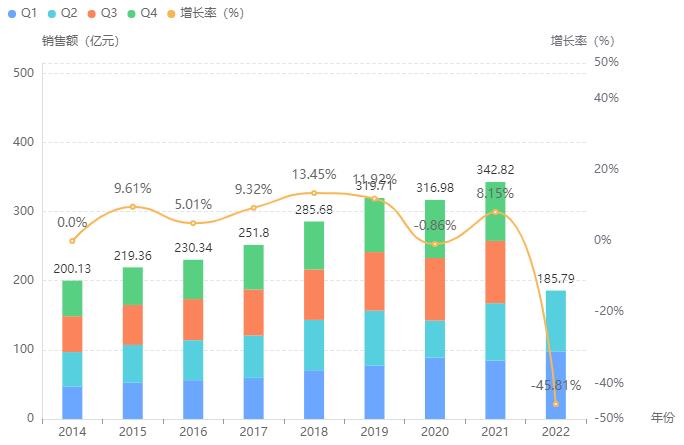
Screenshot Source: Drug Rong Yun National Hospital Sales Database
The market of diabetes drugs is 0.13 billion yuan, and the head effect is obvious.
Diabetes mellitus is a metabolic disease characterized by hyperglycemia in clinic, but the etiology and pathogenesis have not been fully understood at present. Its therapeutic drugs can be divided into two categories: non-insulin hypoglycemic agents and insulin hypoglycemic agents, and subdivided into ten categories: biguanides, insulin and its analogues, GLP-1 receptor agonists, sulfonylureas, glinides and GKA drugs. Jost Sullivan report shows that the current antidiabetic drug market in China is mainly occupied by traditional drugs, and half of it is occupied by insulin.
According to the statistics of Rong Yun Drug Database, among the TOP10 varieties in the hospital sales of diabetes drugs in 2021, except Dapagliflozin tablets, sitagliptin phosphate tablets and liraglutide injection, the other seven varieties are all insulin and its analogues.
Insulin aspart 30 injection and insulin glargine injection topped the list with sales exceeding 3 billion yuan.
TOP10 varieties of in-hospital sales of diabetes drugs market in 2021
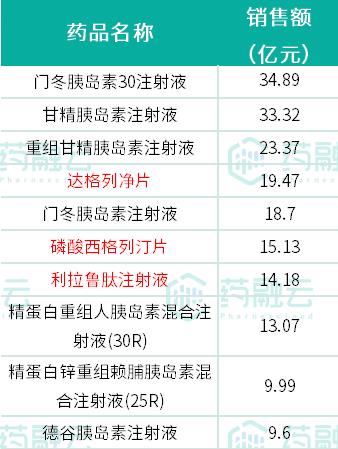
Source: Rong Yun National Hospital Sales Database.
The new diabetes drugs listed in 2022 are remarkable.
Compared with 2021, Hengrui Pharma’s Henggliclazide, Microchip’s Sigliclazide, Tanabe Mitsubishi Pharmaceutical’s Tegliclazide and many other new drugs were approved in China one after another. This year, fewer new diabetes drugs were approved, but all of them were remarkable and very eye-catching.
Hualing Medicine:Dogleetin tablets
On October 8, dorzagliatin, the first in class hypoglycemic agent of Hualing Medicine, was officially approved by NMPA for listing, with the trade name of Huatangning. Two indications of Huatangning were approved at one time, namely, using metformin alone to treat patients with type 2 diabetes who have not been treated with drugs, and using metformin alone in combination with metformin to treat adults with type 2 diabetes when blood sugar control is not good.
This is the world’s first approved GKA,Glucokinase Activator (GKA), the first original new drug with a brand-new mechanism in the field of diabetes in the past decade, and the first new drug for type 2 diabetes in the world launched in China for the first time. As a GKA drug, Dogleetin can restore the blood glucose homeostasis of patients with type 2 diabetes by restoring the function of glucose kinase (GK), and achieve the purpose of treating type 2 diabetes.
Lilly:Tirzepatide; tirzepatide
In May, 2022, FDA approved the listing of tirzepatide (trade name: Mounjaro), a dual agonist of glucose-dependent insulinotropic peptide (GIP) and glucagon-like peptide -1(GLP-1) receptor from Lilly. This drug is the first GLP-1R dual-target hypoglycemic drug for treating type 2 diabetes, and it is only injected once a week to assist diet and exercise, so as to improve the blood sugar control of adults with type 2 diabetes.
Research and development status of tirzepatide

Screenshot Source: Drug Rong Yun Global Drug R&D Database
In China, Lilly submitted the IND application for Telpotide Injection for the first time in April 2019, and started clinical trials in August of the same year. So far, a number of phase III clinical trials for type 2 diabetes, heart failure and obesity have been carried out; In September this year, Lilly officially submitted the marketing application of the new diabetes drug to CDE.
Tirzepatide clinical trial information (search "Medicine Rong Yun applet" for more relevant data query)
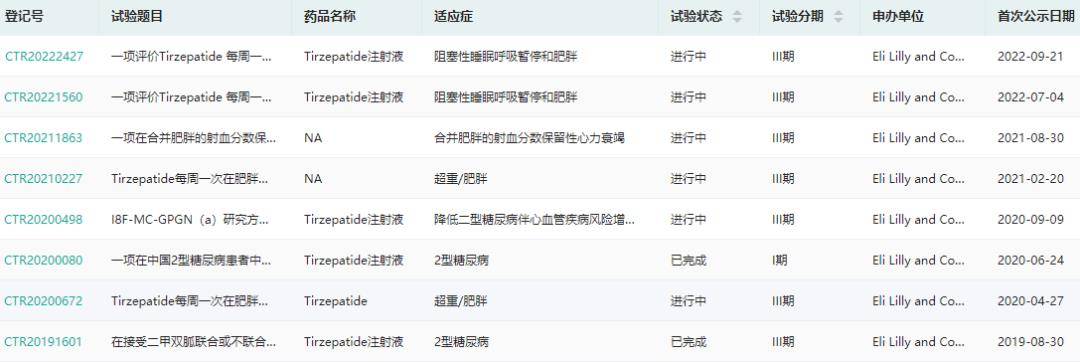
Screenshot Source: Drug Rong Yun China Clinical Trial Database
The research and development market of diabetes drugs has intensified, pending the inventory of new drugs by listed stars.
Under the policy of normalization of quantity procurement and consistency evaluation, the competition in the domestic diabetes generic drug market is gradually becoming fierce, and at the same time, it also forces domestic enterprises to move from generic drugs to Fast-follow and First-in-class.
The research and development of pharmaceutical companies has been accelerated, and many pharmaceutical companies have gathered together hot targets to compete for involution. At present, a number of new diabetes drugs have entered the phase III clinical stage, and some products have submitted listing applications in China.
Newly declared new diabetes drugs in China
Up to now, in addition to the telpotide mentioned above, there are several new diabetes drugs that have been submitted for marketing in the domestic diabetes drug market, which are worthy of attention.
Sihuan medicine:Jiaglinide tablets
On February 28th, the application for the listing of Jiagelijing tablets, a new drug of Sihuan Medicine, was accepted by CDE. This is a glucose sodium cotransporter 2(SGLT-2) inhibitor independently developed by Sihuan Medicine for the treatment of diabetes, which has been patented in China, the United States, Europe, Japan and South Korea for the treatment of type 2 diabetes. If approved for marketing, it will become the second SGLT-2 inhibitor drug independently developed by China after Hengrui Proline Hengglinide Tablets.
Novo Nordisk:Smegliptide tablets
On May 27th, Novo Nordisk’s application for the listing of Smegliptide Tablets was accepted by CDE. Smegliptide is a GLP-1 receptor agonist. Its injection has been approved for marketing in China, and its tablet has been approved for blood sugar control in adults with type 2 diabetes overseas, making it the first oral GLP-1 receptor agonist (GLP-1RA) in the world. According to the Rong Yun database, two phase III clinical trials of Smegliptide tablets compared with placebo or sitagliptin in the treatment of patients with type 2 diabetes have been completed. It is speculated that the declared indication is to treat type 2 diabetes.
Clinical trials of smeagoutide tablets in China

Screenshot Source: Drug Rong Yun China Clinical Trial Database
Hengrui Pharma:Repagliptin phosphate tablets
Repagliptin phosphate tablets in Hengrui Pharma, a DPP-4 inhibitor with similar structure to sitagliptin on the market, are also suitable for type 2 diabetes. It was submitted to the market in September 2020 and accepted. Proline Henggliclazide tablets reported at the same time were approved for marketing on the first day at the end of 2021, becoming the first SGLT-2 diabetes drug independently developed in China. Whether repaglinide can be approved before the end of 2022 is of concern.
Studying new drugs for diabetes.
Novo Nordisk:Icodec
In addition, no weekly insulin preparation products have been approved for listing in the world, and Novo Nordisk’s Icodec insulin is ahead of schedule. On October 3rd, Novo Nordisk announced the positive results of Icodec’s phase IIIa ONWARDS 5 study, and Novo Nordisk also said that it is expected to apply for regulatory approval of Icodec in the United States, the European Union and China in the first half of 2023.
Cinda Bio:Mazdutide(IBI362)
GLP-1 receptor agonists have grown rapidly in recent years, and have become the non-insulin drugs with the highest market share in the global diabetes market, among which dulaglutide, somaru peptide and liraglutide are outstanding. The multi-target agonist of GLP-1R has also become a hot competitive direction in the research and development of new drugs for diabetes.
Among them, the Mazdutide(IBI362) jointly promoted by Cinda Bio and Lilly is eye-catching. This is a GLP-1R/GCGR dual-target agonist, and its research on type 2 diabetes has reached the phase II clinical stage. On July 19th, Cinda Bio announced that a multi-center, randomized, placebo/dulaglutide-controlled phase II clinical study of IBI362 in type 2 diabetic subjects in China reached the main end point, with remarkable hypoglycemic and weight-loss effects, which can bring comprehensive benefits to patients. On October 4th, Cinda Bio announced the phase III clinical trial of IBI362 for overweight or obesity.
Dongyang Guangyao:Rong ge lie Jing
SGLT-2 target is one of the hot targets in the research and development of new drugs for diabetes in recent years. SGLT-2 inhibitors can block and reduce the reabsorption of glucose by the kidney, thus increasing glucose excretion through urination and lowering blood sugar level.
At present, among the SGLT-2 inhibitors under research, Rongglinide of Dongyangguang has made the fastest progress and has reached the clinical stage III. Tagglinide from Tianjin Institute of Medicine, Vanglinide from Fosun Pharma and Agglinide from Shanghai Alice have also entered the clinic.
A variety of clinical phase III DPP-4 inhibitors
There are many DPP-4 inhibitors in the domestic diabetes drug market, among which DBPR108 from Unacon, Fugliptin from Xinlitai, Shenggliptin from Shengshi Taike, HSK7653 from Haisike and Eugliptin from Yuandong Bio have made rapid progress, and all of them have reached the phase III clinical stage.
Zhengda Tianqing Nanjing Shunxin has laid out two models, TQ-F3083 and TQ05510, and increased the horsepower. The former is in the second clinical stage.
Both of them are DPP-4 inhibitors, and there are differences among different varieties. At present, DPP-4 inhibitors are mostly taken once a day, of which HSK7653 of Haisike Pharmaceutical is taken orally once every two weeks, and Eugliptin of Yuandong Biological and Borgliptin of Baidichang Pharmaceutical need to be taken once a week.
Finally, whether it is insulin or non-insulin diabetes drugs, we all look forward to the early listing to provide more choices for diabetic patients.
Notice of Beijing Municipal Commission of Housing and Urban-Rural Development on the Prevention and Control of Pneumonia Infected by novel coronavirus by Property Service Enterprises
Jing Jian Fa [2020] No.15
Housing urban and rural (city) construction committees, housing management bureaus and property service enterprises in all districts:
In order to implement the Notice of the Beijing Municipal People’s Government on Further Defining the Responsibility to Strengthen the Prevention and Control of Pneumonia Infected by novel coronavirus, the Notice of the General Office of the Beijing Municipal Committee of the Communist Party of China on Further Improving the Prevention and Control of Pneumonia Infected by novel coronavirus, and the General Office of the Beijing Municipal People’s Government on Implementing the "Four-Party Responsibility" to further strengthen key groups, Places and Units Notice on Prevention and Control of Pneumonia Infected by novel coronavirus "The Work Plan for Prevention and Control of Pneumonia Infected by novel coronavirus Community (Village) in Beijing (for Trial Implementation)", in accordance with the work requirements of the Municipal Community Prevention and Control Leading Group, relevant matters are hereby notified as follows:
First, all kinds of epidemic prevention and control work carried out by property service enterprises should be incorporated into the community prevention and control system, obey the unified arrangement, unified dispatching and training guidance of the community, and cooperate with the community to do a good job in epidemic prevention and control.
Two, strengthen the prevention and control work organization, do a good job in related property services.
1. Property service enterprises should formulate prevention and control plans one by one according to the situation of each property project, and report to the community for the record with the consent of the community. The plan should specify the responsible person, the telephone on duty, relevant prevention and control measures, emergency response, work requirements and other aspects.
2. Do a good job in regional prevention and control of property management. Under the unified leadership of the community, strengthen the management of environmental sanitation in the property management area and remove garbage in time; Do a good job in ventilation and disinfection of water supply facilities, elevator cars, corridors, public toilets, clubs, garbage stations (buildings) and other key parts and public areas, and publicize work information; Do a good job in the management and registration of foreign vehicles and personnel entering and leaving the community, and establish an information ledger; Cooperate with the community to do a good job in personnel investigation, publicity tips, emergency response and so on.
3. Strengthen internal management. All property service enterprises should earnestly fulfill their responsibilities and urge staff in Beijing to do personal protection during the epidemic and reduce going out; Wear a mask at work, and pay attention to personal hygiene before and after work; Do a good job in monitoring and recording the health of employees. When employees are found to have symptoms such as fever, fatigue and dry cough, they should be urged to go to the fever clinic of the nearest medical and health institution and report to the community; Reduce unnecessary meetings and people gathering in the community; Do a good job in ventilation, sanitation and disinfection of centralized management areas such as staff quarters.
4. Reasonable deployment of staff. During the epidemic prevention and control period, all enterprises should strengthen the post adjustment of internal employees to ensure the basic operation of property services; For employees in the enterprise who are not on the job, it shall be strictly implemented in accordance with the regulations of our city. Employees who are currently returning home to visit relatives in Hubei should inform the employees themselves and shall not leave Hubei to work in Beijing in violation of regulations; Staff returning to Beijing from other areas should report to the community in a timely manner according to the relevant regulations, take prevention and control measures according to the unified requirements of the community, and establish a ledger for staff returning to Beijing, and report the ledger to the community.
5. Establish an information reporting system for epidemic prevention and control. Do a good job in the collection and summary of prevention and control in the property management area, and report in time according to the requirements of community unity.
Third, strengthen inspection and guidance, and implement prevention and control responsibilities.
City and district housing administrative departments should bring the epidemic prevention and control work of the property industry into the unified leadership of the city and district community prevention and control groups, strengthen their work force, make overall arrangements for inspection and guidance, and support and cooperate with the territorial implementation of prevention and control responsibilities.
Beijing Municipal Commission of Housing and Urban-Rural Development
January 30, 2020
Measures for the transfer of rights and interests of toll roads
Ministry of Transport of the People’s Republic of China, National Development and Reform Commission,
Decree No.11, 2008 of People’s Republic of China (PRC) Ministry of Finance
The Measures for the Transfer of Rights and Interests of Toll Roads were adopted at the 7th ministerial meeting on June 15th, 2007, and are hereby promulgated and shall come into force as of October 1st, 2008.
Minister of Transport Li Shenglin
Zhang Ping, Director of the National Development and Reform Commission
Minister of Finance Xie Xuren
August 20th, 2008
Measures for the transfer of rights and interests of toll roads
Chapter I General Principles
the first In order to regulate the transfer of rights and interests of toll roads, safeguard the legitimate rights and interests of the transferor, transferee and users, and promote the development of highway undertakings, these measures are formulated in accordance with the Highway Law of People’s Republic of China (PRC) (hereinafter referred to as the Highway Law) and the Regulations on the Administration of Toll Roads (hereinafter referred to as the Toll Regulations).
the second The transfer of the rights and interests of toll roads within the territory of People’s Republic of China (PRC) shall abide by these measures.
Article The meanings of the following terms in these Measures are:
(1) Toll roads refer to roads (including bridges and tunnels) that are approved to collect vehicle tolls according to the provisions of the Highway Law and the Toll Regulations. Toll roads include government repayment roads and operating roads.
The government loan repayment highway refers to the toll road built by the transportation department of the local people’s government at or above the county level with loans or paid funds from enterprises and individuals.
Operating highway refers to the toll road invested and built by domestic and foreign economic organizations in accordance with the law or the toll road with the right to repay the loan from the government in accordance with the law.
(two) the rights and interests of toll roads refer to the right to charge, the right to operate advertising and the right to operate service facilities.
(3) The term "transfer of rights and interests of toll roads" refers to the trading activities in which the transferor transfers the legally acquired rights and interests of toll roads to the transferee for compensation after the toll roads are completed and opened to traffic.
The transferor refers to the domestic and foreign economic organizations that transfer the legally obtained rights and interests of toll roads to the transferee for compensation according to law, including legal person organizations that specialize in the construction and management of government repayment roads for non-profit purposes and domestic and foreign economic organizations that invest in the construction and operation of operating roads.
The transferee refers to the domestic and foreign economic organizations that have obtained the rights and interests of toll roads from the transferor in accordance with the law.
Article 4 The state allows the transfer of the rights and interests of toll roads according to law, and strictly controls the transfer of the rights and interests of toll roads.
On the basis of comprehensive consideration of the necessity, rationality and social endurance of the transfer, the state strictly restricts the transfer of government repayment roads into operational roads.
The transfer of rights and interests of toll roads shall comply with the provisions of relevant laws, regulations and rules, and shall follow the principles of openness, fairness, impartiality and good faith.
Article 5 The State Council transportation authorities are in charge of the transfer of the rights and interests of national toll roads. The development and reform department of the State Council and the competent financial department are responsible for the management of the transfer of rights and interests of toll roads according to their respective responsibilities.
Chapter II Conditions for Transfer of Rights and Interests of Toll Roads
Article 6 The highway that transfers the toll right shall conform to the technical grade and scale stipulated in Article 18 of the Toll Regulations.
Article 7 Under any of the following circumstances, the toll right in the rights and interests of toll roads shall not be transferred:
(1) Two-lane independent bridges and tunnels with a length of less than 1,000 meters;
(2) Secondary roads;
(3) The charging time has exceeded 2/3 of the approved charging period.
Article 8 The right to charge, the right to operate advertising and the right to operate service facilities of the same toll road project may be transferred together or separately.
Article 9 Transfer the rights and interests of toll roads, shall not have the following acts:
(1) dividing a legally approved toll road project into several sections to transfer the toll right;
(2) Bundling and transferring the rights and interests of toll roads with those of non-toll roads;
(3) The transferee has not completely inherited the responsibilities and obligations originally undertaken by the transferor to the government and the public;
(four) the rights and interests of the government’s repayment of loans are transferred to the enterprise legal person free of charge.
Article 10 The transfer of the rights and interests of toll roads that have not been paid off by international financial organizations or foreign governments shall be approved by the original examination and approval department for the use of foreign loans before applying for transfer examination and approval in accordance with relevant state regulations.
The transferee of the transfer of the rights and interests of toll roads shall, in accordance with the relevant provisions of the state on investment management, report the application report of investment projects to the competent investment department with corresponding management authority for approval before applying for transfer approval. When applying for approval, the contract for the transfer of rights and interests of toll roads shall be submitted at the same time.
Article 11 The transfer of highway toll right shall obtain the consent of the following interested parties:
(1) Creditors of the highway;
(2) The pledgee of the highway toll right;
(3) All investors of the highway;
(4) The person whose consent is required for transfer and retransfer as stipulated in the highway investment and construction contract and the contract for transferring the highway toll right.
Article 12 The transferee of highway toll right shall meet the following conditions:
(a) the financial situation is good, and the owner’s equity of the enterprise is not less than 35% of the actual cost of the transferee project;
(2) It has a good business reputation, and there are no major violations of laws and regulations in economic activities;
(3) Other conditions stipulated by laws and regulations.
When transferring the right to operate highway advertising and service facilities separately, the conditions that the transferee should meet shall be implemented in accordance with local laws and regulations of the provincial people’s government.
Article 13 To transfer the government’s right to charge for road repayment, you can apply to the provincial people’s government to extend the charging period, but the extension period shall not exceed 5 years, and the total accumulated charging period shall not exceed 20 years. The sum of the cumulative charging periods of the central and western provinces, autonomous regions and municipalities directly under the Central Government determined by the state for repayment of highways shall not exceed 25 years at the longest.
The transfer of the right to charge for operating roads shall not extend the charging period, and the total accumulated charging period shall not exceed 25 years. The sum of the cumulative toll collection periods of operating highways in central and western provinces, autonomous regions and municipalities directly under the Central Government determined by the state shall not exceed 30 years at the longest.
It is not allowed to raise the vehicle toll standard on the grounds of transferring the highway toll right.
Chapter III Procedures for Transfer of Rights and Interests of Toll Roads
Article 14 To transfer the right of highway toll collection, before going through the examination and approval of transfer, the transferor may first apply to the examination and approval authority for the transfer project.
To apply for the transfer of the project, the following materials need to be submitted:
(a) the general situation of the highway to which the toll right has been transferred, including the construction period of the highway, the technical level and scale, the source and amount of investment, the toll collection time, and the revenue and expenditure of the toll road in the last three years;
(2) The reason and purpose of the transfer;
(three) the investment of the income from the transfer of government loan repayment roads;
(four) the written opinions of the interested parties agreed to the transfer as stipulated in Article 11 of these Measures;
(five) the transfer of the rights and interests of toll roads that have not been paid off by international financial organizations or foreign governments, and the written consent of the original examination and approval department for the use of foreign loans;
(six) the provincial people’s government approved the collection of vehicle tolls;
(7) The accounting report of the previous year audited by an auditing organ or a qualified accounting firm;
(eight) the transfer of highway toll right for the first time, provide the final financial statements and completion audit report of the toll road;
(nine) the transfer of operating highway toll rights, provide the articles of association;
(ten) to transfer the right of highway toll collection again, and provide the original transfer agreement;
(eleven) other documents that the examination and approval authority deems necessary.
Article 15 After receiving the application for transfer of the project, the examination and approval authority shall conduct a preliminary examination on whether the charging right applied for transfer meets the transfer conditions, and issue a review opinion on the transfer of the project.
The review opinions of the transfer project can be used as the basis for the transferor to prove that the proposed highway toll right meets the transfer conditions when making preparatory work for the transfer.
The review opinions on the transfer project are valid for one year from the date of issuance.
Article 16 To transfer the toll right of the following toll roads, the transferor shall entrust a qualified asset appraisal institution to evaluate the value of the toll right:
(a) the government owing on the loan highway;
(2) Operating highways with financial capital investment;
(three) the use of state-owned capital investment roads.
The appraisal report issued by the asset appraisal institution is the basis for determining the lowest transaction price for the transfer of the toll right of the toll road specified in the preceding paragraph.
The transferor’s asset appraisal report issued by the asset appraisal institution shall be submitted to the relevant departments for approval or filing in accordance with the relevant state provisions on asset appraisal.
Article 17 Where the transferor evaluates the value of the charging right in accordance with the provisions of Article 16, it shall entrust an asset appraisal institution that meets the following conditions:
(1) Having the asset appraisal qualification as stipulated by laws and administrative regulations;
(2) The personnel of the appraisal institution have professional knowledge and experience suitable for the evaluation of the value of highway toll right;
(3) The appraisal institutions and personnel have not committed any violation in the past three years, and have no bad record of violation.
Article 18 When transferring the rights and interests of toll roads, the valuation method should adopt the present value method of income, and the income period involved should be agreed by the transferor and the asset appraisal institution within the approved charging period.
Article 19 The transfer of the rights and interests of the government’s repayment of highway tolls and the rights and interests of operating highway tolls with financial capital investment shall be conducted by public bidding, and the transferee shall be selected fairly, justly and openly.
Article 20 The bidding activities for the transfer of the rights and interests of toll roads shall strictly implement the relevant provisions such as the Bidding Law of People’s Republic of China (PRC).
The transportation department of the provincial people’s government is responsible for the supervision and management of the whole process of bidding for the transfer of rights and interests of toll roads. The development and reform department and the competent financial department of the provincial people’s government shall be responsible for the supervision of bidding activities according to their respective responsibilities.
Article 21 Where the rights and interests of toll roads are transferred by tender, the transferor shall issue a tender announcement through newspapers, information networks or other media designated by the state. The announcement period shall not be less than 20 days.
Article 22 Where the rights and interests of government repayment roads are transferred and the rights and interests of operating roads with financial capital investment and state-owned capital investment are used for bidding, a reserve price bidding shall be implemented. Among them, the reserve price of the transfer of the right to charge shall not be lower than the evaluation price of the value of the right to charge approved or confirmed by the relevant departments.
Article 23 The transferor shall prepare the tender documents according to law. The tender documents shall include the following contents:
(a) the basic situation of the project subject to tender, including the project construction period, opening time, technical level and scale, investment sources and investment amount, income and expenditure in recent years, etc.;
(two) the transferee shall have the conditions and relevant qualifications and credit requirements. When transferring the rights and interests of government repayment roads and operating roads with financial capital investment, the transferee shall be required to promise that the established highway management enterprises will not provide external guarantees, including providing any form of guarantee for the transferee’s debts and will not bear the transferee’s debts;
(3) The rights and obligations of the transferee;
(4) The payment form, term (no longer than 6 months after the contract comes into effect) and guarantee requirements of the transfer money;
(5) Requirements for highway maintenance, greening and soil and water conservation during the operation period;
(six) the procedures for dissolution and liquidation after the end of the operation, and the standards for highways and highway ancillary facilities and service facilities when the rights and interests of highways are transferred;
(seven) the conditions for the bankruptcy, termination and dissolution of the transfer agreement of the transferee or the highway operation enterprise established by it;
(eight) the conditions for the government to terminate the agreement on the transfer of rights and interests of toll roads;
(nine) the requirements for the preparation of bidding documents and their delivery methods, places and deadlines;
(ten) the place of bid opening and the time arrangement of bid opening and bid evaluation;
(eleven) evaluation criteria, evaluation methods, evaluation procedures, and factors to determine the waste target;
(twelve) the main terms of the signed transfer contract;
(thirteen) the employee placement plan;
(14) A scheme for handling creditor’s rights and debts;
(fifteen) other issues that need to be explained.
Article 24 After the transferee is determined, the transferor and the transferee shall conclude a contract for the transfer of rights and interests of toll roads according to law.
The transfer contract shall include the following clauses:
(1) Names and domiciles of the transferor and transferee;
(2) The name and business content of the project;
(3) Business scope and transfer period;
(four) the transfer price and the time (not more than 6 months after the contract comes into effect) and method of payment;
(5) Matters related to asset delivery;
(6) The employee placement plan involved by the transferor;
(seven) the rights and obligations of the transferor;
(eight) the rights and obligations of the transferee;
(nine) highway maintenance and service quality assurance measures (including the establishment of maintenance deposit, etc.);
(10) Responsibility for business risks;
(eleven) highway maintenance responsibility;
(twelve) the way and time of highway handover;
(thirteen) the way to solve the dispute;
(fourteen) the parties’ liability for breach of contract;
(15) Conditions for the alteration and dissolution of the contract;
(sixteen) the ownership and transfer of highway toll right after the expiration of the transfer contract;
(17) Other terms deemed necessary by both parties.
Article 25 The contract for the transfer of highway toll rights and interests shall take effect from the date of approval of the transfer of highway toll rights.
Article 26 The transfer of the toll right of national highways (including national trunk lines and national expressway network projects, the same below) shall be approved by the competent department of transportation of the State Council. The transfer of other highway toll rights other than the national highway shall be approved by the provincial transportation department and reported to the provincial people’s government for approval.
The merger and transfer of highway advertising management right, service facility management right and highway toll right shall be approved by the examination and approval authority with the authority to examine and approve highway toll right.
The examination and approval of the separate transfer of the right to operate highway advertising and service facilities shall be carried out in accordance with local regulations and the rules of the provincial people’s government.
Article 27 To apply for the transfer of highway toll right, the transferor shall submit the application documents to the examination and approval authority, which shall include:
(1) Where an application for project establishment has been filed, the examination opinions on project establishment transfer shall be submitted; If an application for project establishment has not been submitted, relevant materials specified in Article 14 shall be submitted;
(two) the relevant materials and asset appraisal report approval or filing documents for the valuation of the charging right in accordance with the provisions in the early stage of the transfer;
(three) the bidding situation in the early stage of the transfer and the determination of the transferee;
(4) A copy of the transferee’s accounting report for the previous year and the transferee’s legal person business license issued by the auditing department or accounting firm;
(five) the relevant procedures and written consent in accordance with the provisions of article tenth;
(six) the specific investment of the transfer income;
(seven) the management of highway toll rights and interests;
(eight) the transfer contract of highway toll rights signed by the transferor and the transferee;
(nine) other documents that the examination and approval authority deems necessary.
Article 28 The examination and approval authority shall, in accordance with the requirements of the Administrative Licensing Law and relevant regulations, handle the examination and approval of the transfer of highway toll right.
When examining the application for the transfer of rights and interests of toll roads, the examination and approval authorities shall comprehensively consider the factors that safeguard national interests and social public interests.
If it agrees to transfer the right of highway toll collection, the examination and approval authority shall issue an approval document for the transfer of highway toll collection right.
Article 29 If the people’s government at the provincial level approves the transfer of highway toll right, the transferor shall, within 30 days from the date of approval, report the examination opinions of the provincial transportation authorities, the approval documents of the provincial people’s government and the transfer contract to the the State Council transportation authorities for the record.
Article 30 The State Council transportation authorities shall, within 30 days from the date of approval of the transfer of highway toll right, send a copy of the approval document to the competent department of development and reform of the State Council and the competent department of finance.
Article 31 The transferor shall be responsible for the authenticity and legality of the application materials submitted.
Chapter IV Management of the Use of Transfer Income
Article 32 The income from the transfer of the government’s rights and interests in repaying loans on highways shall be used for highway construction except for repayment of highway construction loans and paid fund-raising. No unit may use the income from the transfer of the rights and interests of the government’s repayment of loans for projects other than highway construction.
The part of the income obtained from the transfer of the rights and interests of operating highways with financial capital investment corresponding to the share of financial capital investment is mainly used for highway construction except for repayment of highway construction loans.
Article 33 The income from the transfer of all the rights and interests of operating roads invested by social funds shall be determined by the investors themselves.
The relevant state departments should encourage investors to continue to invest this part of their income in highway construction projects.
Article 34 The income obtained from the transfer of the rights and interests of government repayment roads and the rights and interests of operating roads with financial capital investment shall be included in the budget management. The transferor shall, within 3 working days after obtaining the above-mentioned transfer income, turn it over to the finance according to the prescribed budget levels. The implementation of non tax revenue collection management system reform, in accordance with the relevant provisions of the reform. The competent financial department shall incorporate the transfer income into the fiscal revenue and expenditure budget of the current year, and the funds shall be allocated in accordance with the relevant provisions of the fiscal treasury management system.
Chapter V Follow-up Management and Recovery of Rights and Interests Transfer of Toll Roads
Article 35 The transferee has the rights and interests of highway toll collection within the transfer period according to law, and the ownership of the highway and highway ancillary facilities transferred with the rights and interests of toll roads is still owned by the state.
Article 36 Upon the expiration of the transfer period stipulated in the toll road rights transfer contract, the roads, highway ancillary facilities and service facilities that transfer the toll road rights should be in good technical condition, recovered by the state free of charge, and managed by the transportation authorities.
If the transfer period of the rights and interests of the toll road is not full, and the state recovers the transferred rights and interests of the toll road in advance due to social and public interests, the competent transportation department that receives the rights and interests of the toll road shall compensate the transferee according to law. The maximum compensation is calculated and determined according to the proportion of the original transfer price and the period of early recovery to the original approved transfer period.
Article 37 After the transfer of the rights and interests of the toll road, the responsibilities of the road administration shall still be exercised by the agencies and personnel of the transportation departments of the local people’s governments at or above the county level or the highway management agencies.
Article 38 After the transferee obtains the rights and interests of the toll road in accordance with the law, the legally established highway management enterprise shall, in accordance with the standards and specifications stipulated by the state, do a good job in highway maintenance management, greening and soil and water conservation within the scope of highway land use, and carry out daily inspection, testing and maintenance of the toll road and facilities along it to ensure that the toll road is in a good technical state.
Highway management enterprises shall, according to the requirements of the competent department of transportation, provide regular inspection reports on highway technical conditions.
Article 39 Highway management enterprises shall accept the industry management of the transportation departments of the State Council and the people’s governments of provinces, autonomous regions and municipalities directly under the Central Government, implement network charging as required, and abide by other unified requirements of the road network, and provide statistical data and relevant business conditions in a timely manner.
Article 40 After the transfer of the rights and interests of toll roads, the competent transportation departments of provinces, autonomous regions and municipalities directly under the Central Government shall supervise and inspect the toll management and maintenance of the toll roads.
Six months before the expiration of the transfer period stipulated in the contract for the transfer of the rights and interests of toll roads, the competent transportation departments of the people’s governments of provinces, autonomous regions and municipalities directly under the Central Government shall identify and accept the toll roads that have transferred their rights and interests. After identification and acceptance, if the highway meets the technical grade and standard approved at the time of transfer of the rights and interests of toll roads, the highway management enterprise may, in accordance with the relevant provisions of the state, go through the formalities of highway transfer to the competent transportation department at the expiration of the transfer period; Do not meet the technical level and standards approved when transferring the rights and interests of toll roads, highway management enterprises shall carry out maintenance within the time limit determined by the competent department of transportation, and only after meeting the requirements can they go through the formalities of highway handover in accordance with the regulations. If the transfer period fails to meet the requirements, the competent transportation department shall take back the right of highway toll collection, go through the formalities of highway handover, and designate other units to carry out maintenance, and the maintenance costs shall be borne by the original highway operation enterprises.
Chapter VI Legal Liability
Article 41 In violation of the provisions of these measures, unauthorized approval of the transfer of rights and interests of toll roads shall be investigated and dealt with in accordance with the provisions of Article 47 of the Toll Regulations.
Article 42 In violation of the provisions of article ninth of these measures, the competent department of transportation of the State Council or the provincial competent department of transportation shall be ordered to make corrections according to their functions and powers; The responsible person in charge and other directly responsible personnel shall be given administrative sanctions according to law; If a crime is constituted, criminal responsibility shall be investigated according to law.
Article 43 In violation of the provisions of these measures, the transferor shall select the transferee through bidding without bidding, or the procedures and contents of bidding do not conform to the provisions of these measures, and shall be investigated and dealt with in accordance with the relevant provisions of the Bidding Law of People’s Republic of China (PRC).
Article 44 In violation of the provisions of these measures, social intermediary institutions resort to deceit when auditing or evaluating the toll road rights transfer project, or the accounting report and evaluation report issued by them are seriously untrue, and according to the seriousness of the case, the relevant institutions shall punish them in accordance with the provisions of relevant national laws and regulations.
Article 45 In violation of the provisions of these measures, one of the following acts shall be investigated and dealt with in accordance with the provisions of Article 52 of the Regulations on Charges:
(1) The transferor fails to pay the full amount of the income corresponding to the share of financial capital investment in the income from the transfer of the rights and interests of the government’s loan repayment highway and the income from the transfer of the rights and interests of the operating highway with financial capital investment;
(II) The transportation department and the financial department will not use the income corresponding to the share of financial capital investment in the income from the transfer of the rights and interests of the government’s loan repayment highway and the rights and interests of the operating highway with financial capital investment for repayment of loans or paid fund-raising and for highway construction, and will use the transfer income for other purposes.
Article 46 In violation of the provisions of these measures, the transferee fails to fulfill the obligations of soil and water conservation within the scope of highway maintenance, greening and highway land use, and shall be investigated and dealt with in accordance with the provisions of Articles 54 and 55 of the Charge Regulations.
Article 47 In violation of the provisions of these measures, the examination and approval authority and its staff in any of the following circumstances shall be investigated and dealt with in accordance with the provisions of Articles 72 and 74 of the People’s Republic of China (PRC) Administrative Licensing Law:
(a) the examination and approval opinions are not issued within the time limit prescribed in these Measures;
(two) the application for the transfer of rights and interests of toll roads that do not meet the statutory conditions and procedures is approved, or the application is approved beyond the statutory authority;
(three) in the process of acceptance and examination, the transferor was not informed of all the contents that must be supplemented at one time.
Article 48 In the process of examining and approving the transfer of the rights and interests of toll roads, the staff of the examination and approval authorities ask for or accept other people’s property or seek other benefits, and shall be investigated and dealt with in accordance with the provisions of Article 73 of the Administrative Licensing Law of People’s Republic of China (PRC).
Chapter VII Supplementary Provisions
Article 49 The time limit stipulated in these Measures shall be calculated in working days, excluding legal holidays.
Article 50 These Measures shall come into force as of October 1, 2008. On October 9, 1996, the Ministry of Communications issued the Measures for the Administration of Paid Transfer of Highway Management Rights by Decree No.9 of the Ministry of Communications, which shall be abolished at the same time.